Creating the perfect learning environment requires thoughtful consideration of lighting design. Proper classroom illumination directly impacts student focus, mood, and academic performance while reducing eye strain and fatigue. With advances in LED technology and smart lighting systems, educators now have numerous innovative options to transform their teaching spaces. From energy-efficient solutions to creative ambient lighting, these twenty classroom lighting ideas will help you design an engaging, comfortable, and productive learning environment that supports both teaching and learning activities.
1. LED Panel Classroom Lighting for Uniform Illumination
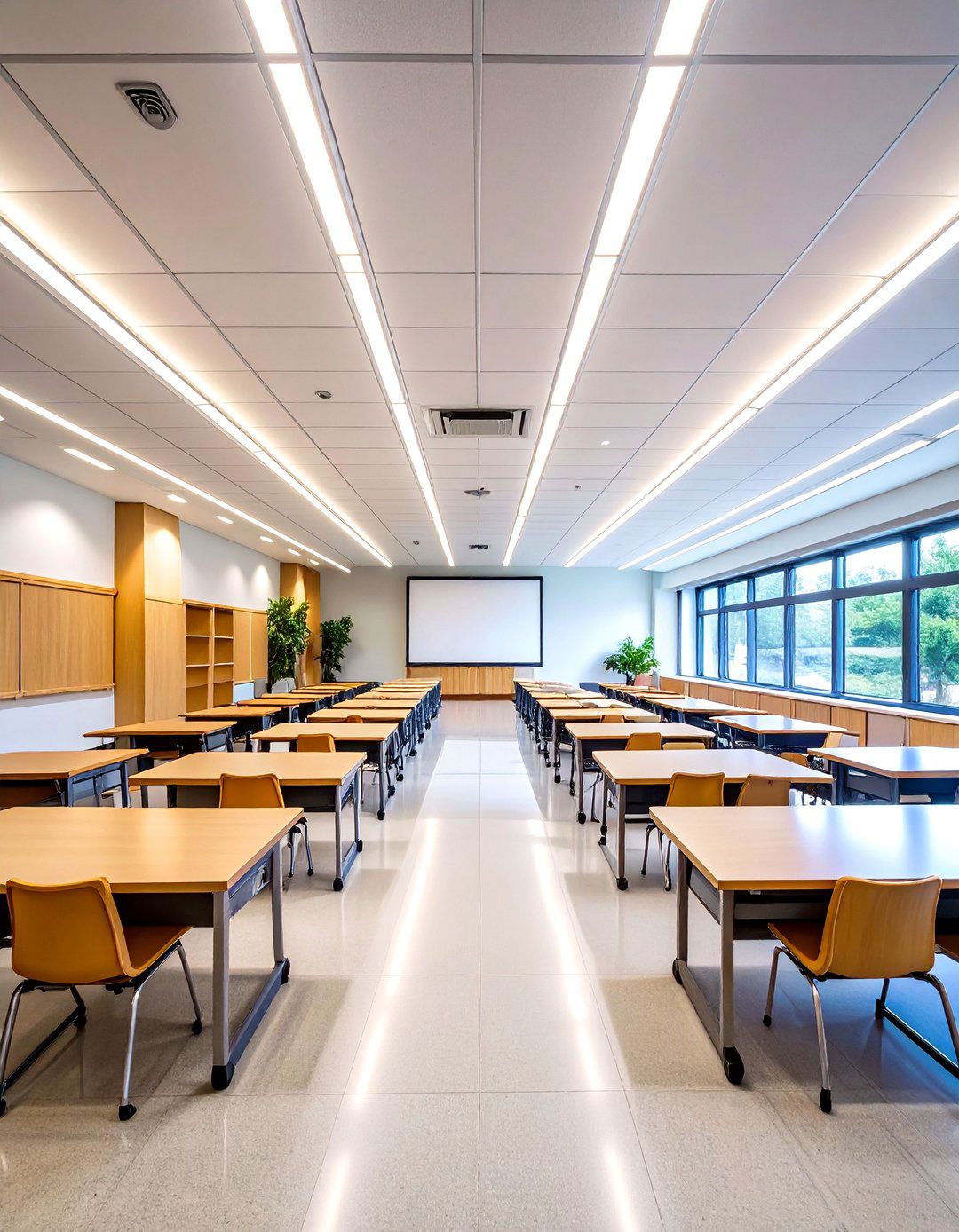
LED panel lights provide smooth, even distribution of light while minimizing shadows and glare, making them ideal for standard classroom applications. These fixtures can be recessed into ceilings or surface-mounted, creating a sleek, modern appearance that complements contemporary classroom design. For a standard classroom of around 60 square meters, a range of 30,000 to 60,000 lumens is generally recommended. The uniform lighting distribution ensures every student can see clearly regardless of their seating position, while the flicker-free operation prevents headaches and eye strain. LED panels also offer superior energy efficiency compared to traditional fluorescent fixtures, making them a sustainable choice for educational institutions seeking to reduce operating costs.
2. Natural Daylight Integration Classroom Lighting
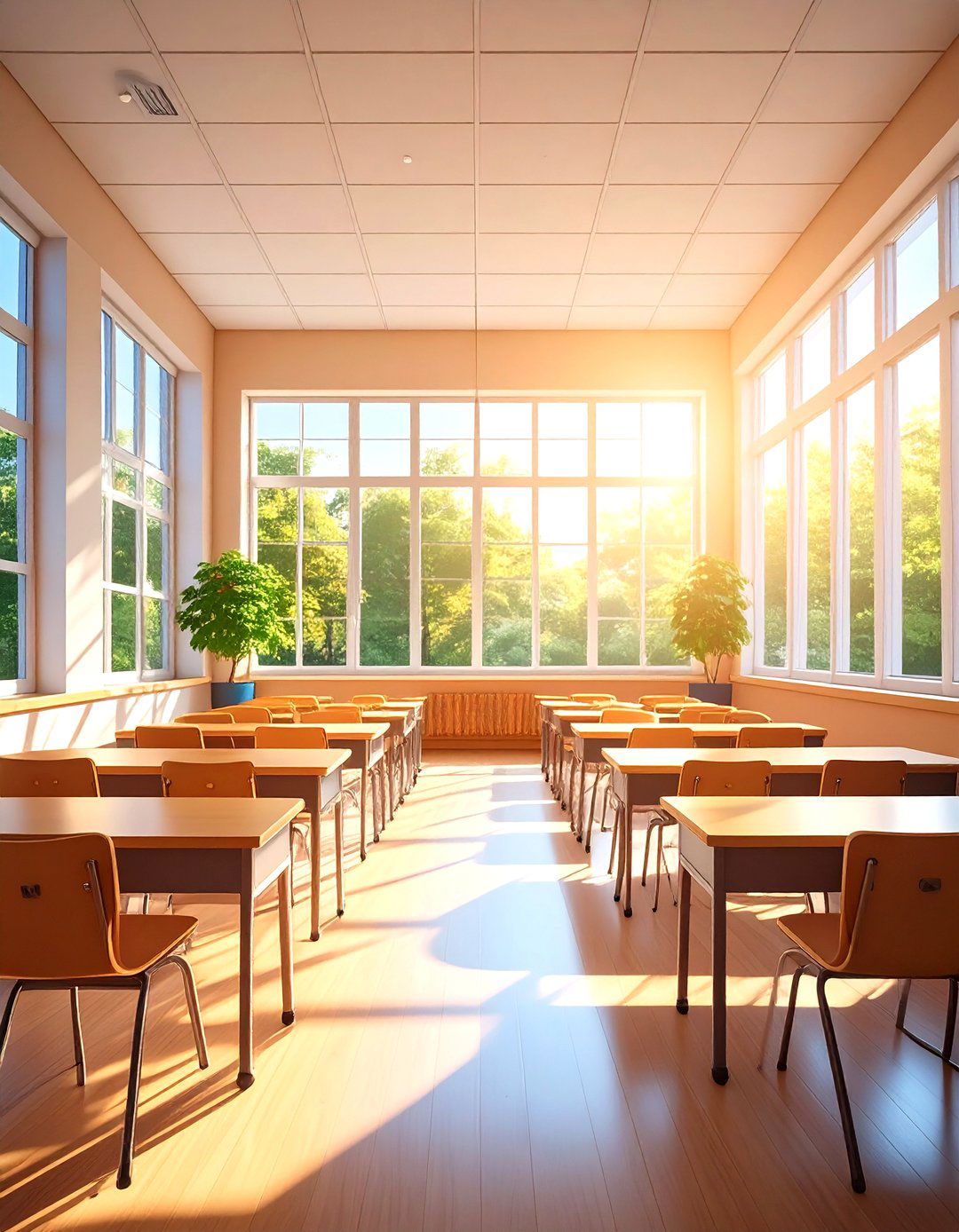
Natural light is the best and most important light to incorporate into the classroom, providing physical and physiological benefits to both students and teachers. Maximizing natural sunlight through strategic window placement and management creates an optimal learning environment while reducing reliance on artificial lighting. Natural sunlight creates a relaxed learning environment and keeps students focused and alert. Consider installing adjustable window treatments that allow teachers to control light levels throughout the day, preventing glare on whiteboards while maintaining adequate illumination. This approach not only improves student well-being but also significantly reduces energy consumption during daylight hours, supporting green school initiatives.
3. Smart Color-Changing Classroom Lighting Systems
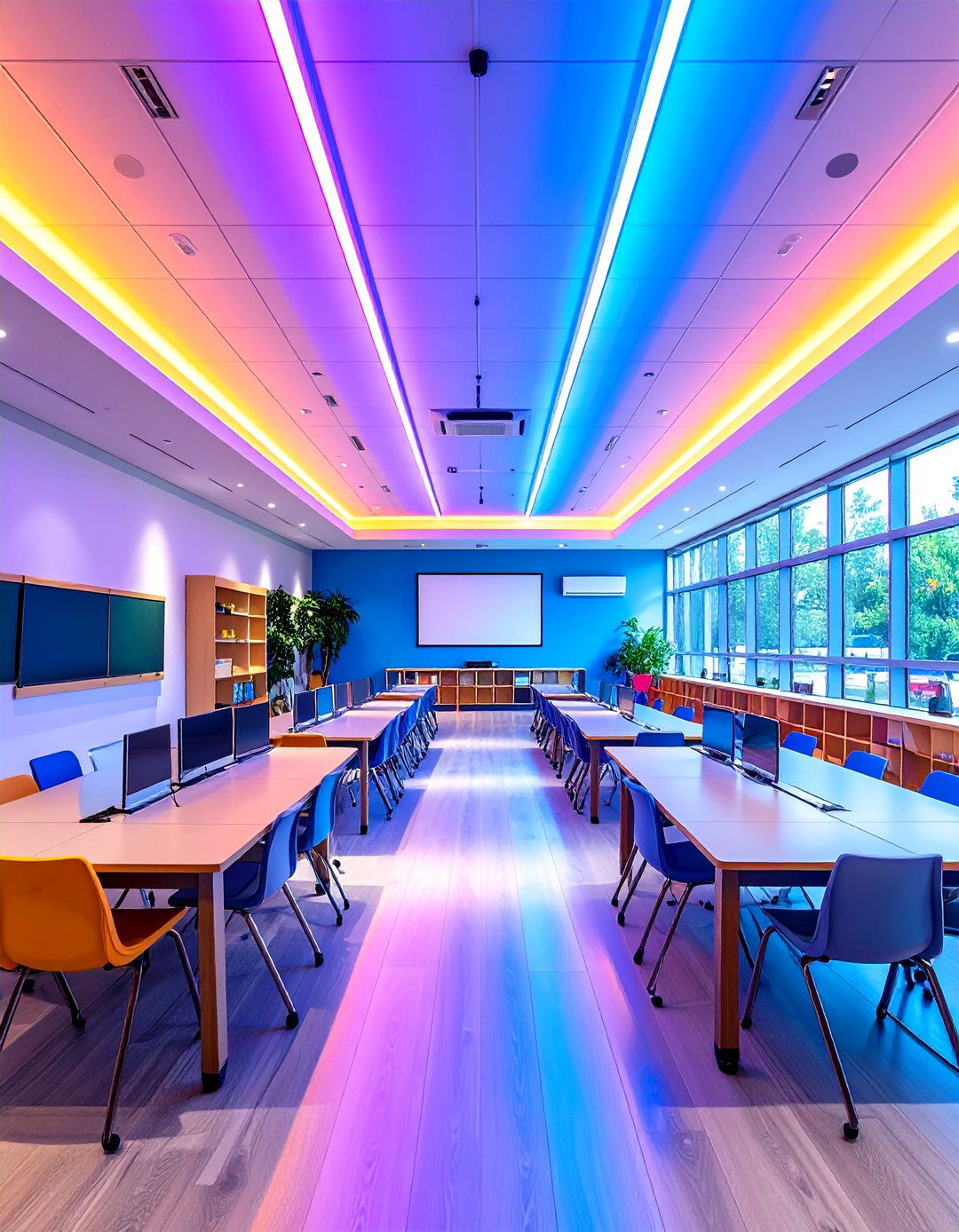
Smart lighting systems allow teachers to change color and intensity based on activities, using soft lighting for reading and bright lighting for discussions to enhance focus. These advanced systems can be programmed to automatically adjust throughout the day, supporting students' natural circadian rhythms. Cooler color temperatures (4000K to 5000K) are ideal for concentration during exams, while warmer tones (2500K to 3000K) work better for relaxed settings or creative activities. Teachers can easily switch between different lighting scenes using smartphone apps or wall controls, creating the perfect atmosphere for various learning activities. The technology also enables energy optimization by automatically dimming lights when sufficient natural light is available.
4. Pendant Classroom Lighting for Aesthetic Appeal

Suspended luminaires distribute light efficiently without glare, providing even lighting in the workspace while maintaining good balance between direct light at workspaces and ambient lighting against walls and ceilings. Pendant lights add visual interest to classroom design while delivering functional illumination that supports learning activities. The best lighting for classrooms with children aged 7 to 12 years combines direct and indirect light, where pendant luminaires with 70% uplight and 30% downlight create optimal conditions. Modern pendant systems can incorporate smart controls and adjustable heights to accommodate different ceiling configurations. These fixtures work particularly well in elementary classrooms where creating a warm, welcoming atmosphere is essential for young learners' comfort and engagement.
5. LED Strip Classroom Lighting for Accent and Cove Applications
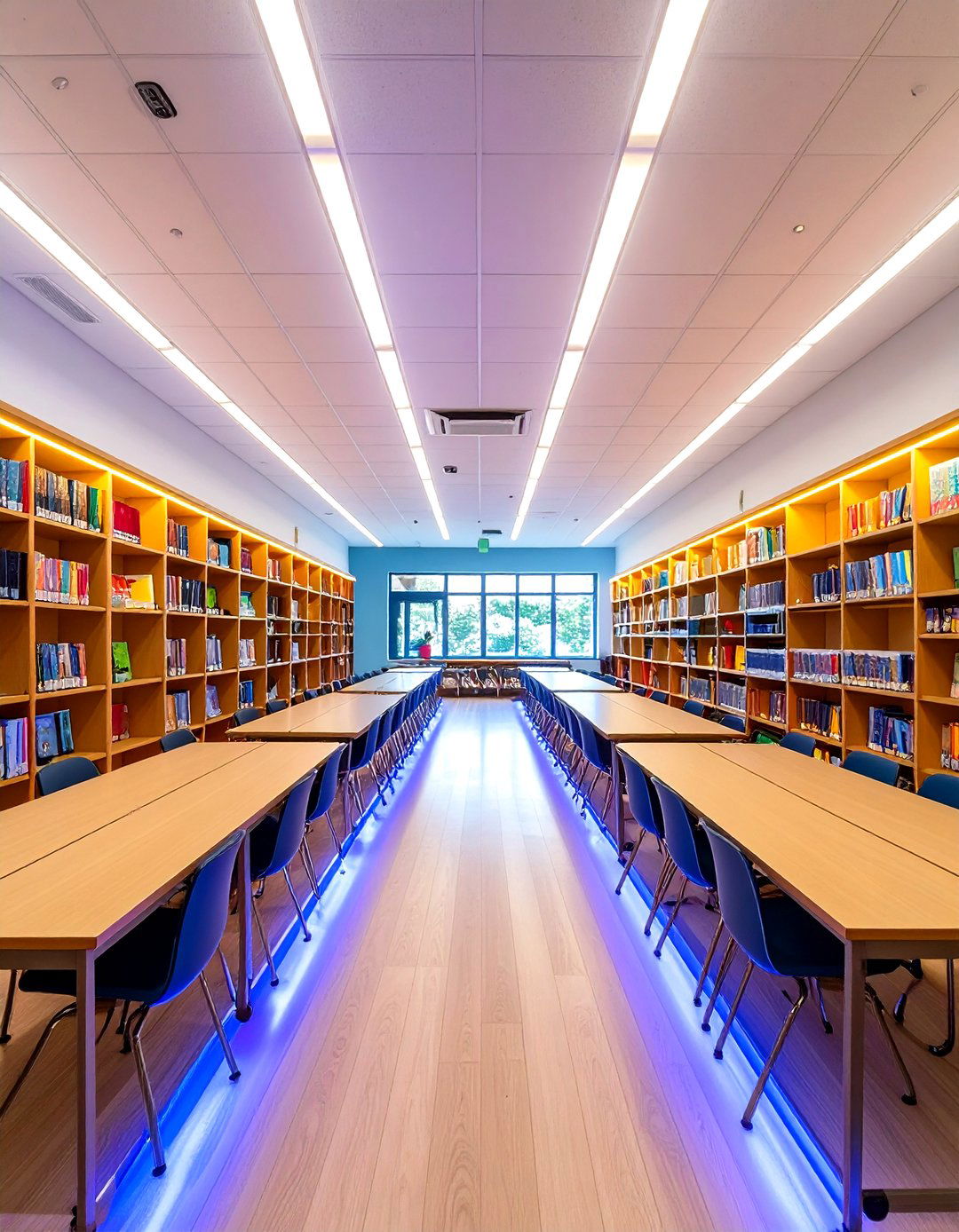
LED strip lights can be used for under-cabinet lighting for lab counters, along bookshelves, or in cove lighting to add indirect light while enhancing visual interest. This versatile lighting solution allows for creative illumination of specific classroom areas while providing practical task lighting where needed. Installing color-changing LED strips allows teachers to adjust lighting based on lesson mood or time of day, enhancing student engagement. Strip lights can highlight architectural features, create reading nooks, or provide subtle ambient lighting that reduces harsh contrasts. Their low profile design makes them ideal for retrofitting existing classrooms without major renovation work, while their energy efficiency helps schools maintain sustainable lighting practices.
6. Track Classroom Lighting Systems for Flexibility
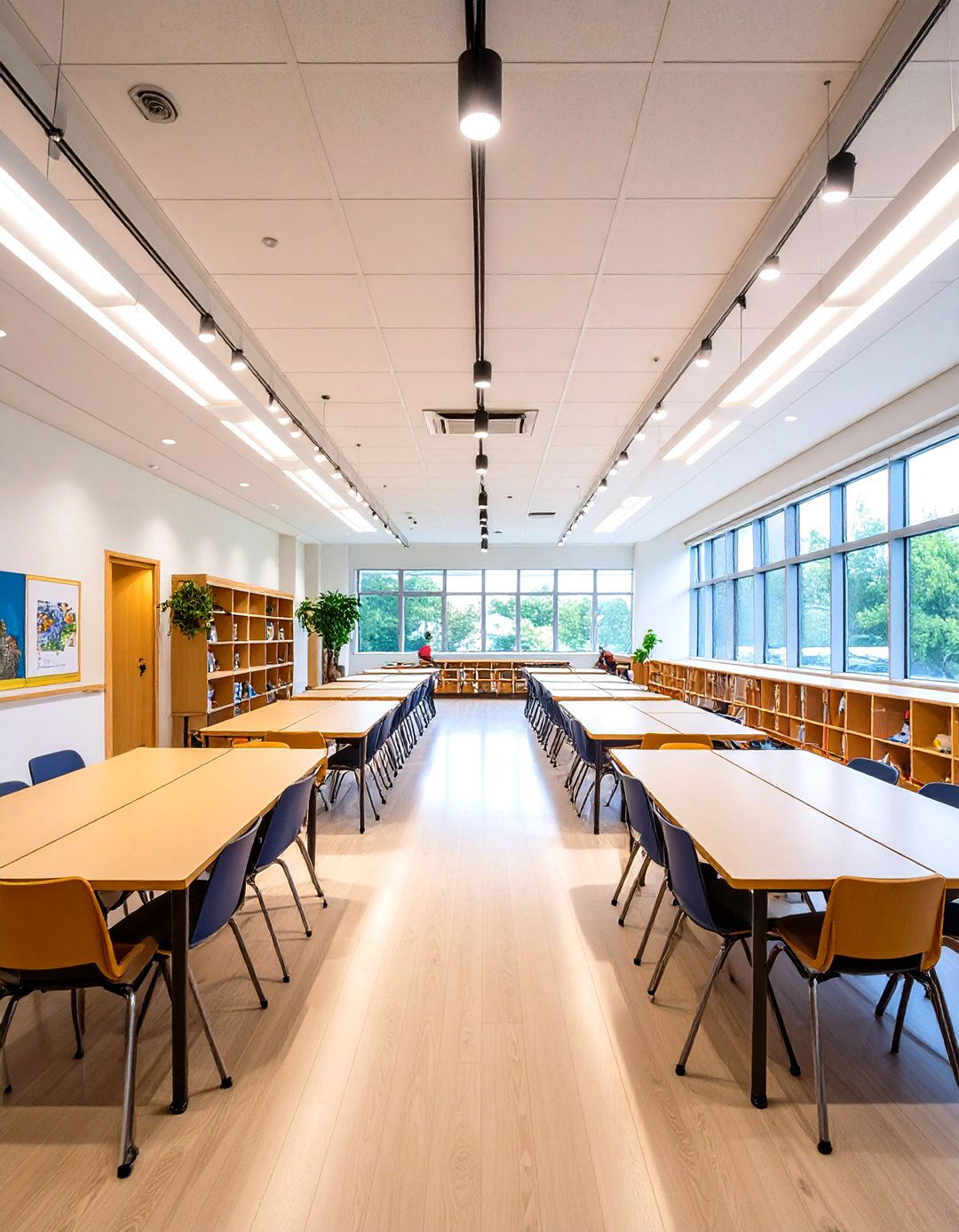
Track lighting systems offer unmatched versatility for classroom illumination, allowing educators to direct light exactly where it's needed for different activities and room configurations. With adjustable heads and multiple fixtures, track lighting allows you to direct light exactly where needed, making it ideal for dynamic and ever-changing spaces. This flexibility proves invaluable in modern classrooms that frequently rearrange furniture for group work, presentations, or different learning activities. The system can illuminate specific areas such as reading corners, art stations, or science demonstration areas while providing general ambient lighting. Track lighting also accommodates future classroom modifications without requiring extensive electrical rewiring, making it a cost-effective long-term solution for evolving educational spaces.
7. Desk Lamp Classroom Lighting for Individual Work Stations
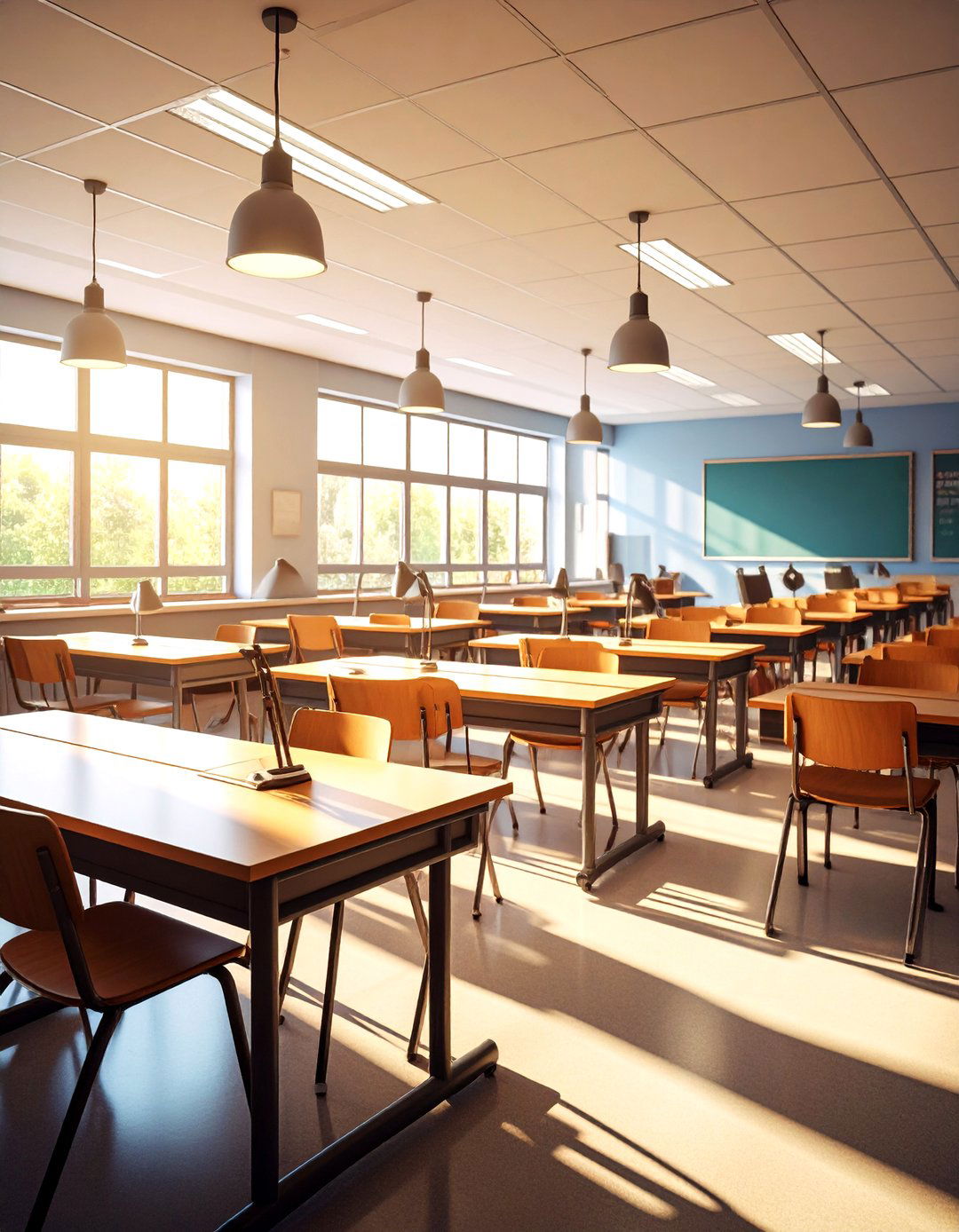
Adjustable desk lamps provide focused light directly onto students' materials, offering flexible lighting solutions for reading corners or individual workstations. These portable fixtures give students control over their personal lighting environment, accommodating different visual needs and preferences. Study lamps should provide clear, bright light with relatively focused beam and minimal glare, positioned 15-36 inches above the work area. Individual desk lighting proves particularly valuable for students with visual impairments or attention difficulties who benefit from enhanced task illumination. Modern LED desk lamps offer adjustable color temperature and brightness levels, allowing students to customize their lighting for different activities such as reading, writing, or computer work.
8. String Light Classroom Lighting for Cozy Atmosphere
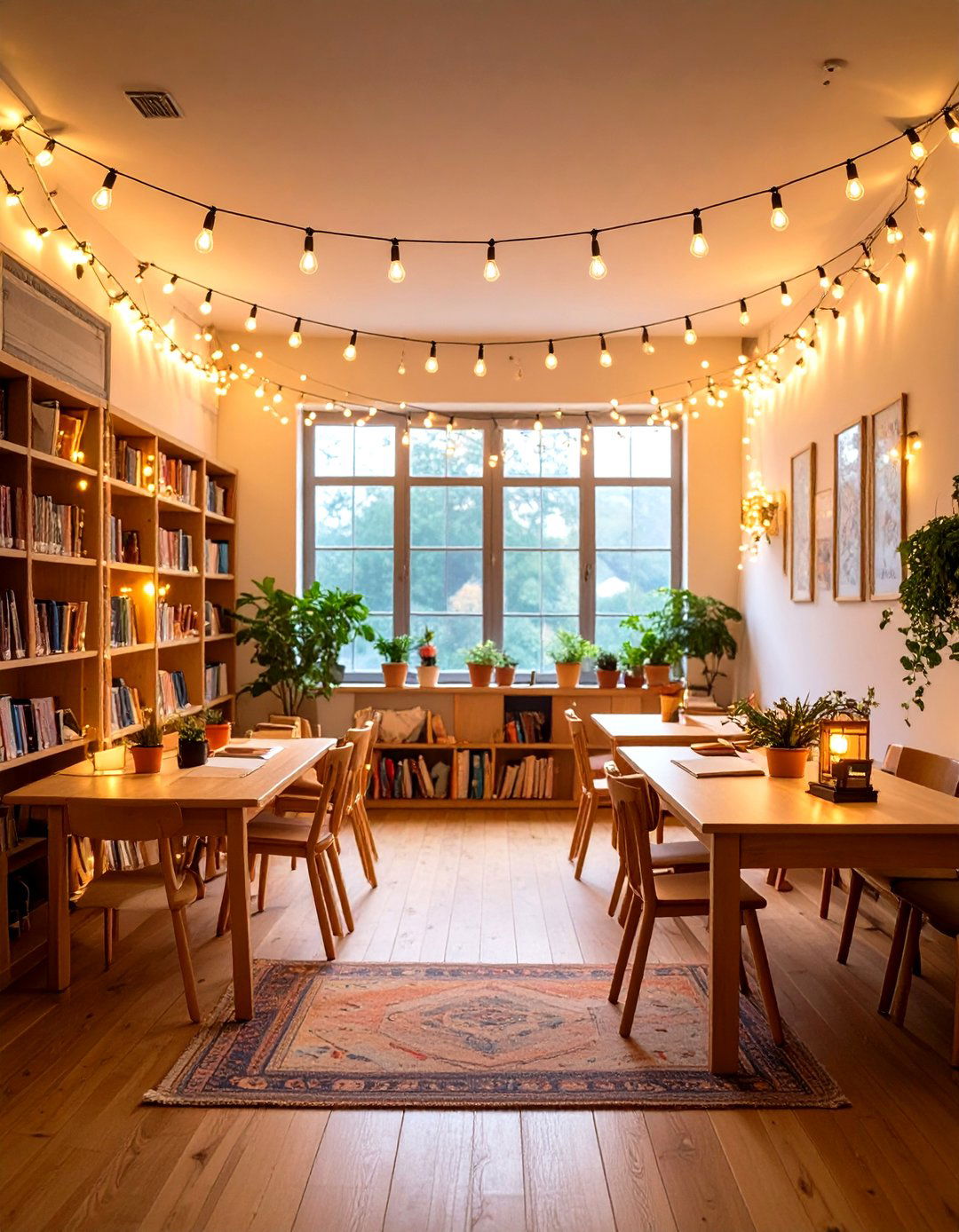
String lights create a cozy and inviting ambiance, making learning fun while providing soft glow that creates a more tranquil environment perfect for puzzles, audiobooks, or reading. This affordable lighting solution transforms classroom atmosphere by adding warmth and visual interest to learning spaces. String lights work exceptionally well in reading corners, library areas, or calm-down spaces where students need a softer, more relaxed environment. Draping string lights along bulletin boards or windows adds a cozy touch that makes the classroom feel more welcoming. Teachers can use warm white LED string lights to reduce energy consumption while maintaining the desired ambiance. The gentle illumination helps create emotional comfort for students, particularly beneficial during stressful periods or for students with anxiety.
9. Floor Lamp Classroom Lighting for Reading Areas
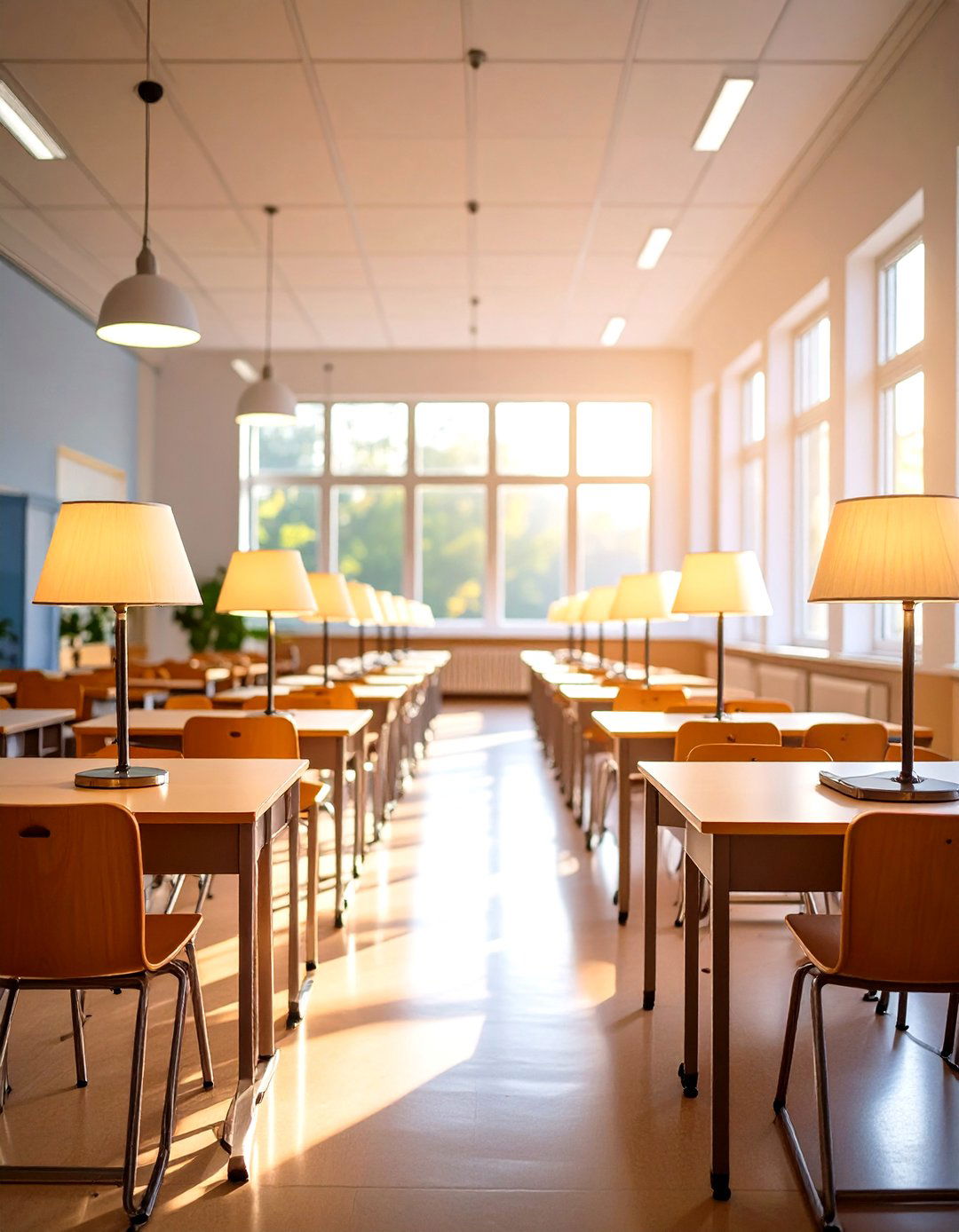
Floor lamps positioned at the front of the classroom or in reading areas provide additional lighting that helps with visibility while creating well-lit spaces. These portable fixtures offer teachers flexibility to illuminate specific areas without permanent electrical modifications. Floor lamps work particularly well in reading corners, library spaces, or teacher presentation areas where additional task lighting enhances functionality. Warm yellow bulbs between 60-80 watt equivalent LED bulbs provide the best classroom illumination while lasting longer and offering superior energy efficiency. The ability to easily relocate floor lamps allows teachers to adapt lighting configurations for different activities, seasonal changes, or classroom reorganization, making them valuable additions to any flexible learning environment.
10. Emergency Classroom Lighting for Safety Compliance
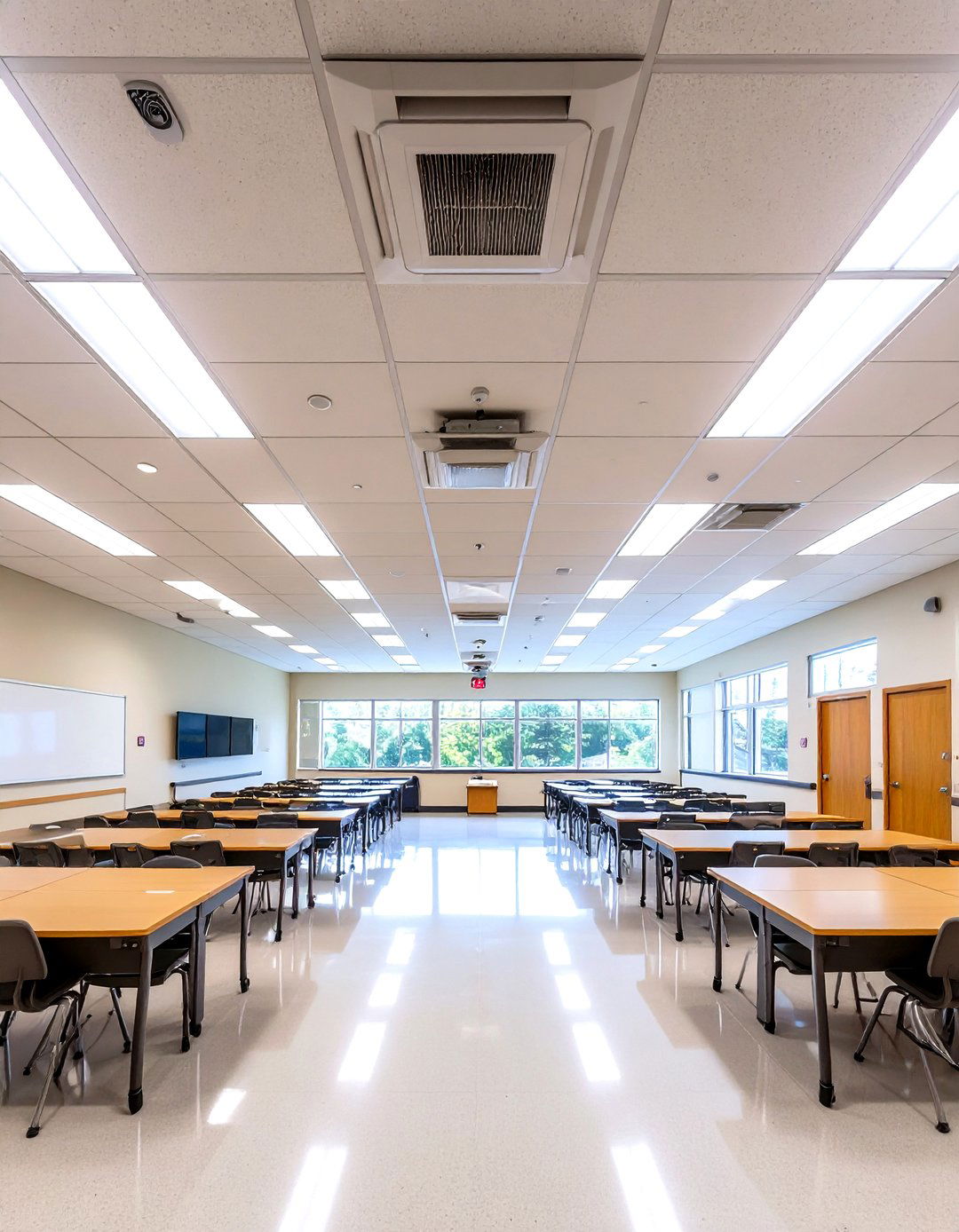
Emergency lighting is a must-have safety feature in any educational facility, operating during power failures to provide clear visibility and guide occupants safely out of the building. These critical safety systems ensure continuous illumination during emergencies, meeting required building codes and protecting student welfare. Emergency lights must provide illumination for a minimum of 90 minutes after power loss and offer initial illumination of at least 1 footcandle average. Modern emergency lighting systems integrate seamlessly with classroom design while providing reliable backup power through built-in batteries. Regular testing and maintenance of emergency lighting ensures compliance with NFPA 101 Life Safety Code requirements. Schools must prioritize these systems to maintain safe egress routes and protect students, teachers, and staff during unexpected power outages or emergency situations.
11. Suspended Linear Classroom Lighting for Modern Aesthetics
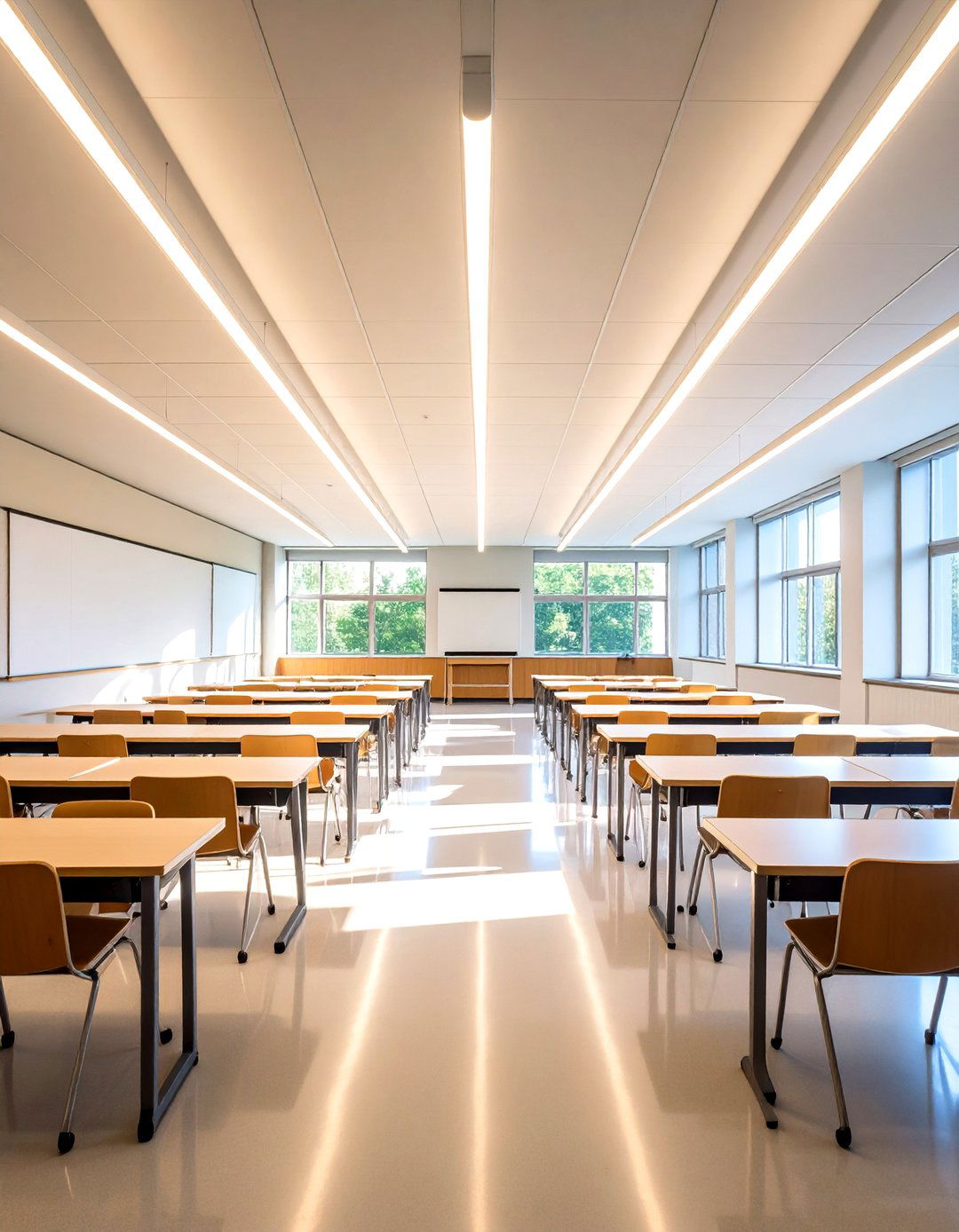
Suspended LED lighting provides sleek and modern aesthetic while delivering uniform, glare-free illumination that complements classroom design. These linear fixtures create clean lines and contemporary appearance while ensuring effective task and ambient lighting throughout the learning space. Suspended linear systems can be arranged in multiple rows to achieve optimal illumination levels for different classroom sizes and configurations. Multiple rows of luminaires in classrooms ensure sufficiently high light levels while providing lighting control to adapt energy consumption. The sophisticated appearance appeals to modern educational environments while maintaining functionality. These systems often incorporate dimming capabilities and smart controls, allowing teachers to adjust lighting intensity based on activities, time of day, or available natural light.
12. Cove Classroom Lighting for Indirect Illumination
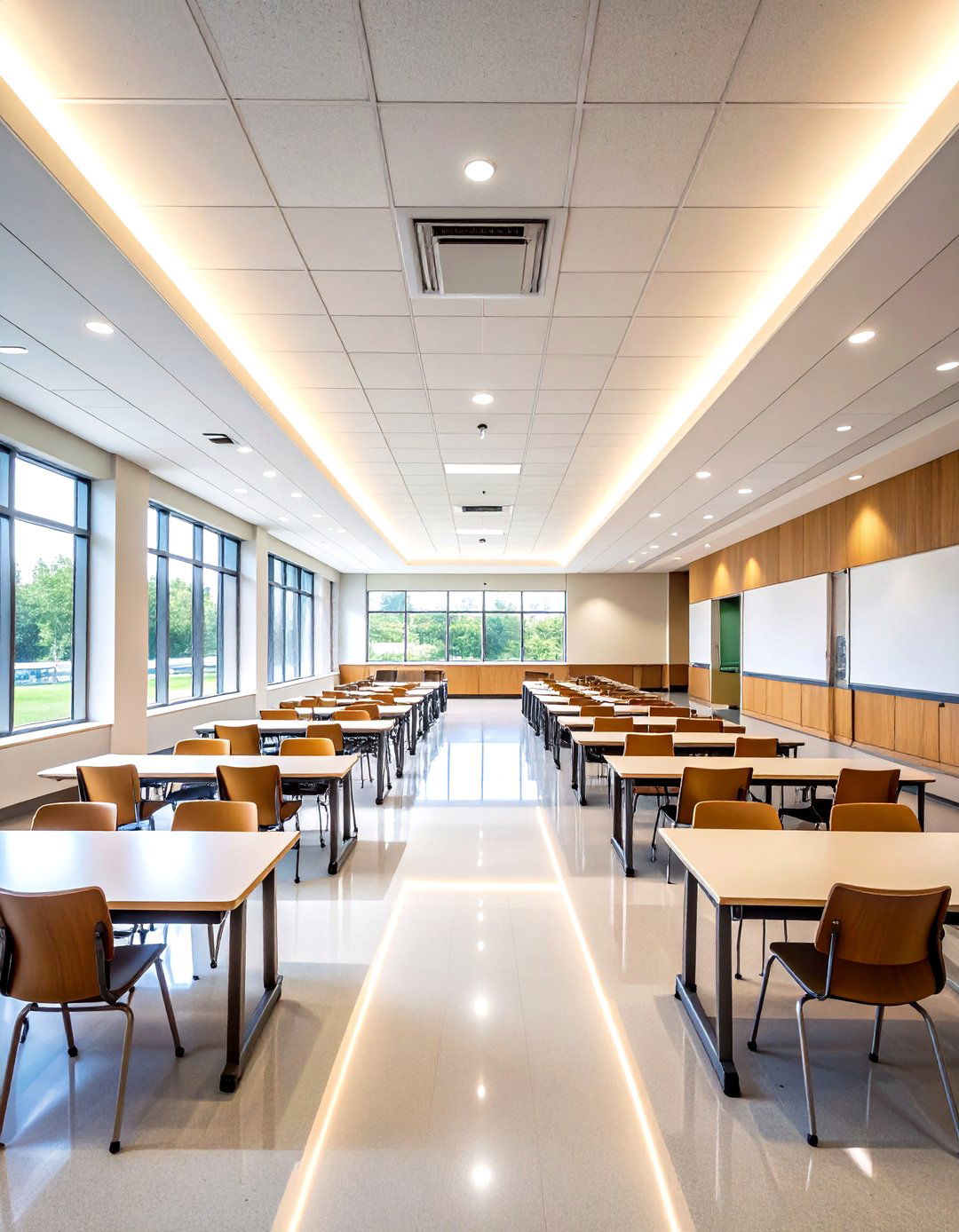
LED cove lighting creates versatile and stylish ambient illumination in classrooms by concealing light sources while highlighting architectural features and enhancing overall aesthetic appeal. This sophisticated lighting technique provides soft, indirect illumination that reduces glare and creates comfortable visual environments. Cove lighting creates diffused lighting by reflecting off surfaces to provide soft, even distribution of light while hiding the source from view. The technique proves particularly effective in elementary classrooms where harsh lighting can cause discomfort for young students. Cove lighting can highlight architectural details, create visual depth, and establish calming atmospheres conducive to learning. When combined with other lighting systems, cove lighting provides layered illumination that adapts to various classroom activities while maintaining energy efficiency through LED technology.
13. Interactive LED Panel Classroom Lighting

Interactive light panels that respond to touch or movement encourage students to engage with their surroundings, making learning more dynamic and interactive. These innovative fixtures combine illumination with educational technology, creating opportunities for hands-on learning experiences. Interactive lighting systems can be programmed to respond to student movement, support STEM education, or provide visual feedback during lessons. The technology engages students in new ways while maintaining practical classroom illumination. Teachers can integrate these systems into science lessons about light, color, and technology, making abstract concepts more tangible. Interactive panels also support students with different learning styles by providing visual and kinesthetic engagement opportunities. These advanced systems represent the future of educational lighting, where illumination becomes an active component of the learning process.
14. Portable Rechargeable Classroom Lighting
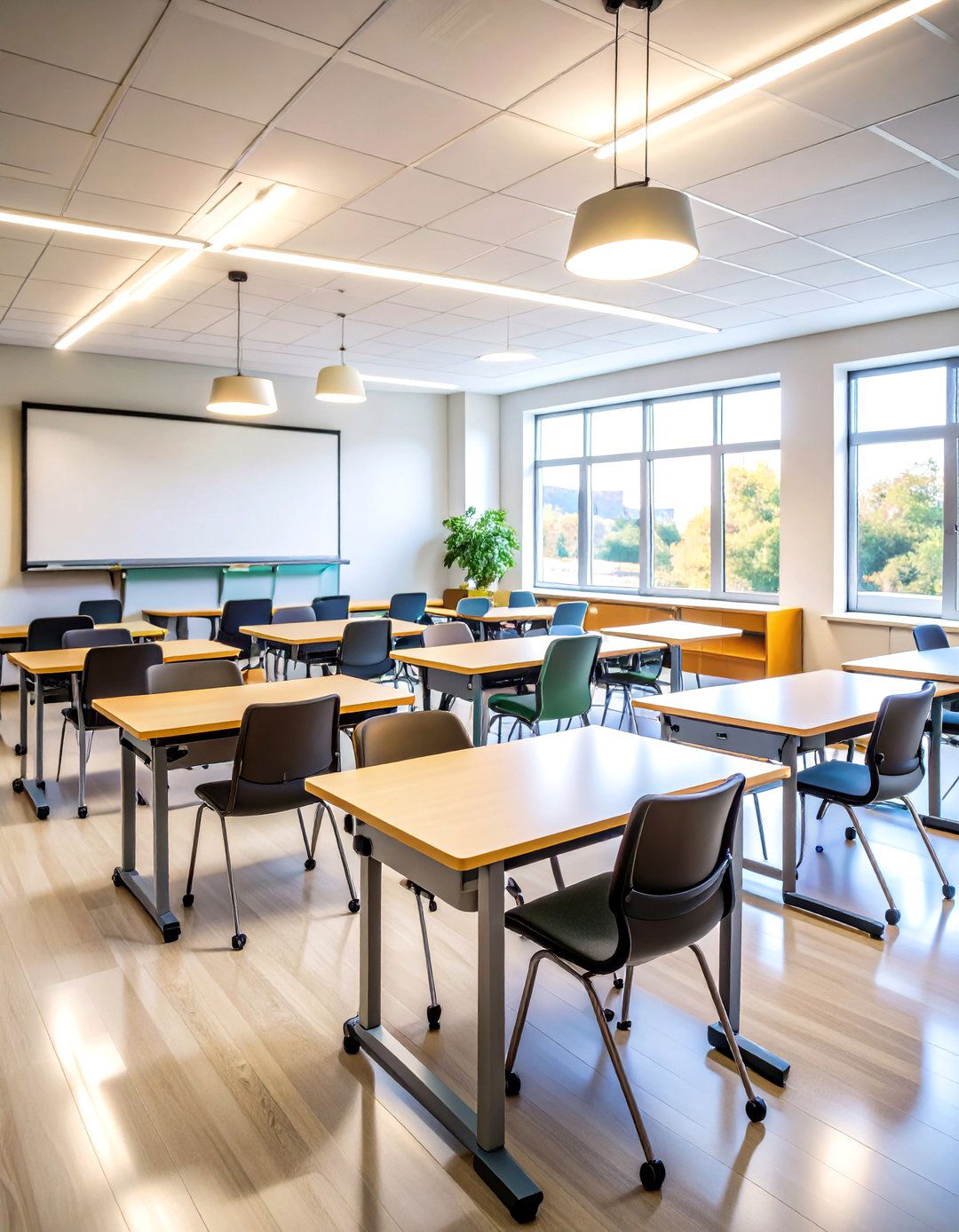
Rechargeable lighting is becoming the new normal in design, with portable options making bright debuts that bridge functionality and convenience. These battery-powered fixtures provide lighting flexibility for outdoor classes, emergency situations, or areas without convenient electrical access. Portable LED lights offer teachers the ability to illuminate specific areas during demonstrations, field trips, or temporary classroom setups. Portable USB LED light bars serve multiple functions as reading lights, desk lamps, emergency lights, and outdoor lighting solutions. The rechargeable technology eliminates cord management issues while providing reliable illumination for various educational activities. Modern portable classroom lights feature adjustable brightness, color temperature options, and long battery life. These solutions prove invaluable for flexible learning environments, outdoor education programs, or emergency preparedness planning.
15. Paper Lantern Classroom Lighting for Cultural Learning
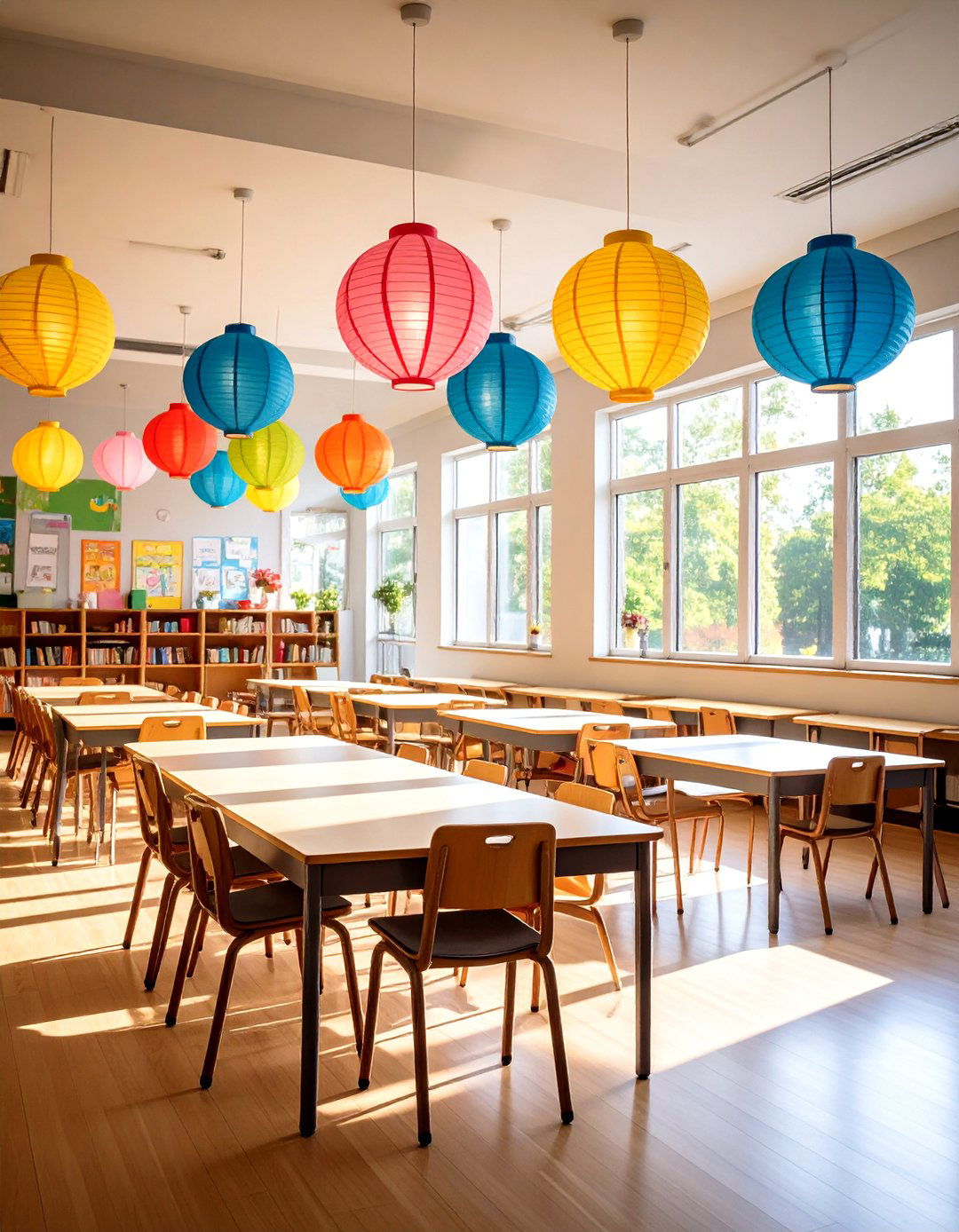
Paper or fabric lanterns suspended from the ceiling create cozy atmosphere while adding cultural elements to lessons, enriching students' learning experiences. These decorative lighting elements combine illumination with educational opportunities, introducing students to different cultural traditions and artistic styles. Paper lanterns provide soft, diffused lighting that creates warm, welcoming environments particularly suitable for reading areas or quiet learning spaces. Teachers can incorporate lantern-making activities into art or social studies curricula, connecting lighting with hands-on learning experiences. Paper globes provide soft and lightweight options for ambient lighting while providing gentle glow that enhances mood. The affordable nature of paper lanterns allows for seasonal decoration changes and student participation in classroom design, fostering ownership and engagement in their learning environment.
16. LED Bay Classroom Lighting for Large Spaces
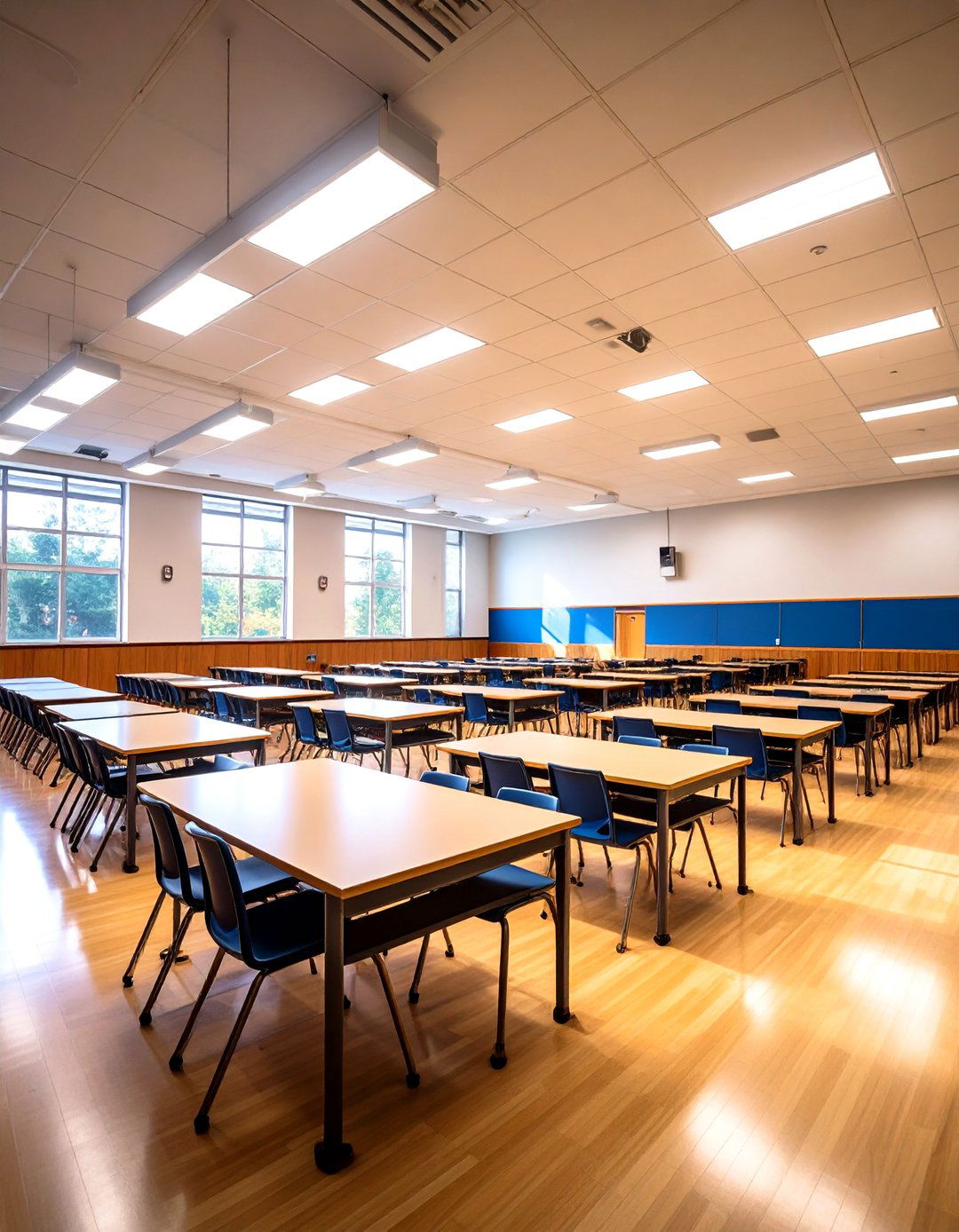
LED bay lights deliver powerful, bright light from above for larger areas such as auditoriums, gymnasiums, or high-ceiling classrooms, ensuring ample illumination for activities requiring expansive coverage. These high-output fixtures address the unique challenges of illuminating large educational spaces while maintaining energy efficiency. Bay lighting systems provide uniform illumination across wide areas, eliminating dark spots that can compromise safety or visibility. The fixtures work particularly well in multipurpose rooms, cafeterias, or assembly halls where high light levels are necessary for various activities. Their energy efficiency makes them smart choices for spaces that need significant light over extended periods. Modern LED bay lights offer dimming capabilities and can be integrated with occupancy sensors to optimize energy usage when spaces are unoccupied.
17. Under-Desk Classroom Lighting for Student Comfort
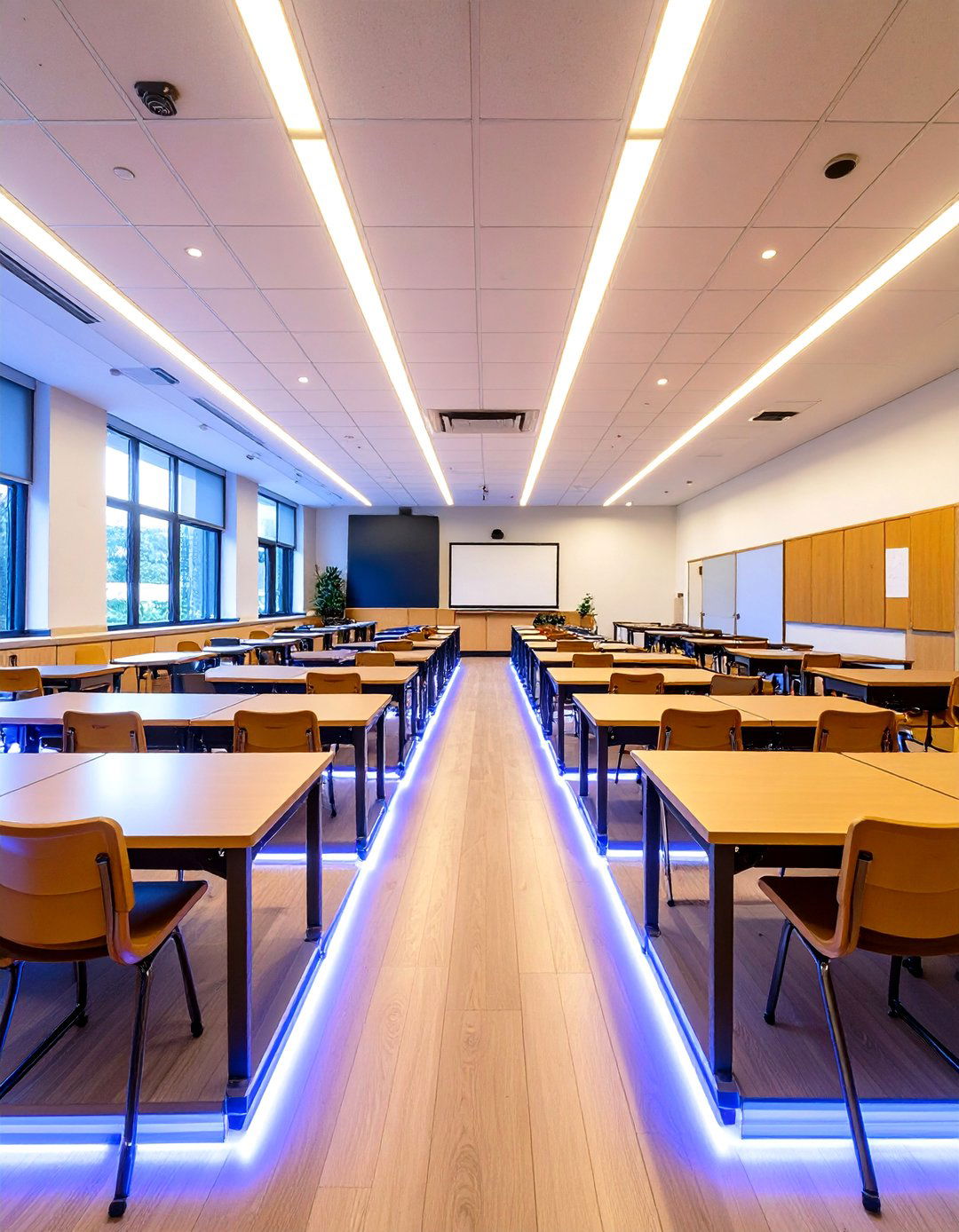
Soft LED strips installed under desks create calming effects that help reduce harshness of overhead lights, making classrooms feel more comfortable and inviting. This innovative lighting approach addresses student comfort by providing gentle upward illumination that supplements overhead lighting without creating glare. Under-desk lighting particularly benefits students who are sensitive to bright overhead illumination or experience visual stress in traditional classroom settings. The soft illumination creates a more homelike atmosphere that can reduce anxiety and improve focus for sensitive students. LED strips used for this application consume minimal energy while providing significant comfort benefits. Teachers report that under-desk lighting helps create calmer classroom environments, particularly beneficial during testing periods or for students with attention difficulties who benefit from reduced visual stimulation.
18. Projector-Based Ambient Classroom Lighting
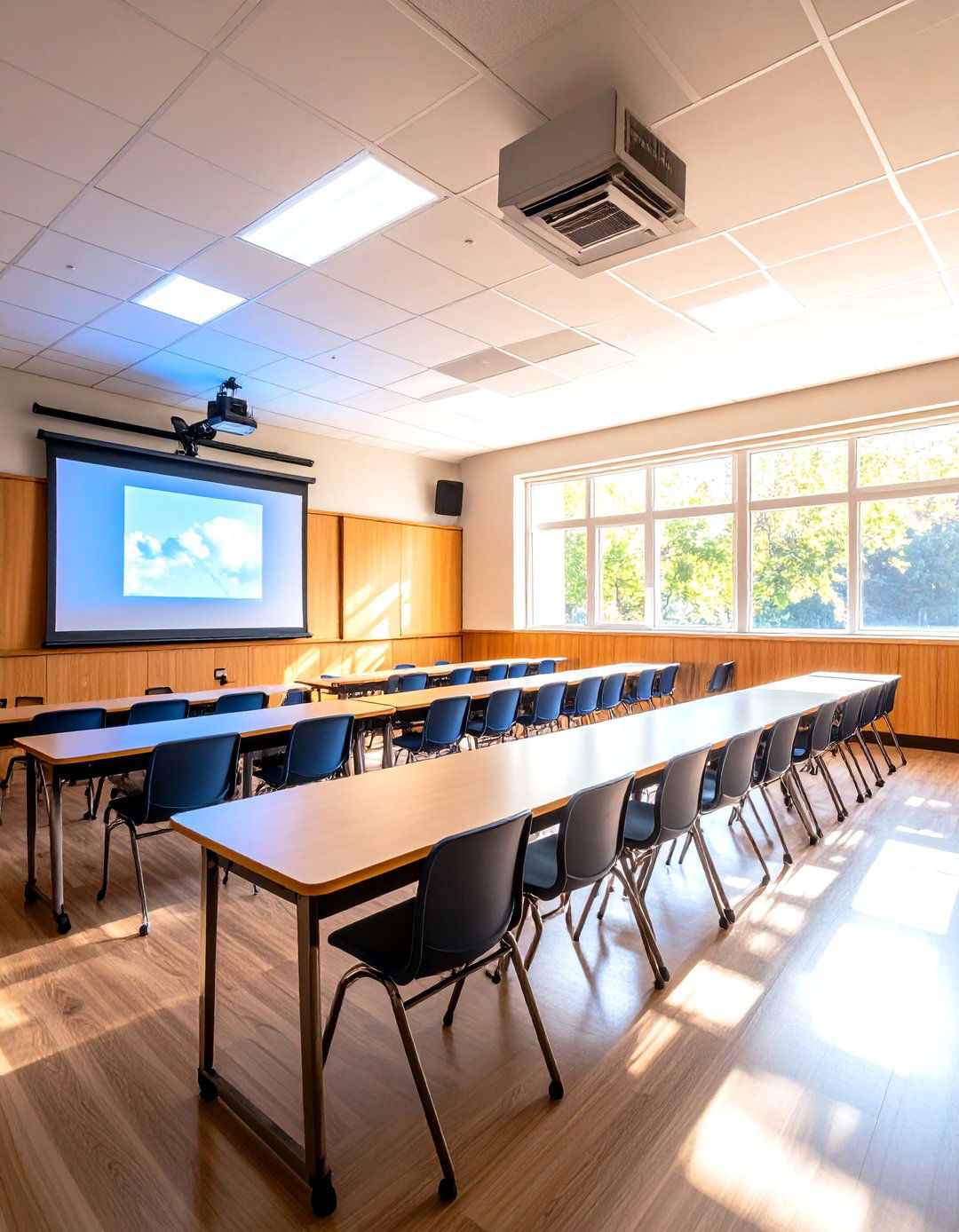
Using projectors to display calming images or educational visuals on walls adds ambiance while reinforcing lesson content, making learning more visually appealing. This technology-integrated lighting solution combines practical illumination with educational content delivery, creating immersive learning environments. Projector lighting can transform plain classroom walls into dynamic educational displays that support curriculum objectives while providing ambient illumination. Teachers can project nature scenes during reading time, historical images during social studies, or constellation patterns during science lessons. The technology allows for immediate environmental changes that align with lesson content, maintaining student engagement through visual interest. Modern LED projectors offer energy-efficient operation while providing bright, colorful displays that enhance both lighting and learning simultaneously.
19. Wall Wash Classroom Lighting for Display Areas

Wall wash lighting provides even illumination along walls, highlighting student artwork, educational displays, and classroom materials while creating visual interest. This specialized lighting technique ensures that bulletin boards, student work displays, and educational posters receive adequate illumination for optimal visibility. Wall wash lighting is mounted on ceilings near wall-ceiling intersections to provide even light distribution that accentuates materials and textures. The technique proves particularly valuable in classrooms that frequently display student work or rotate educational materials on wall surfaces. Wall washing eliminates shadows and uneven lighting that can make displays difficult to read or appreciate. Modern LED wall wash fixtures offer adjustable beam angles and dimming capabilities, allowing teachers to highlight specific displays or adjust lighting intensity based on classroom activities.
20. Dimmable Classroom Lighting Systems for Activity Adaptation
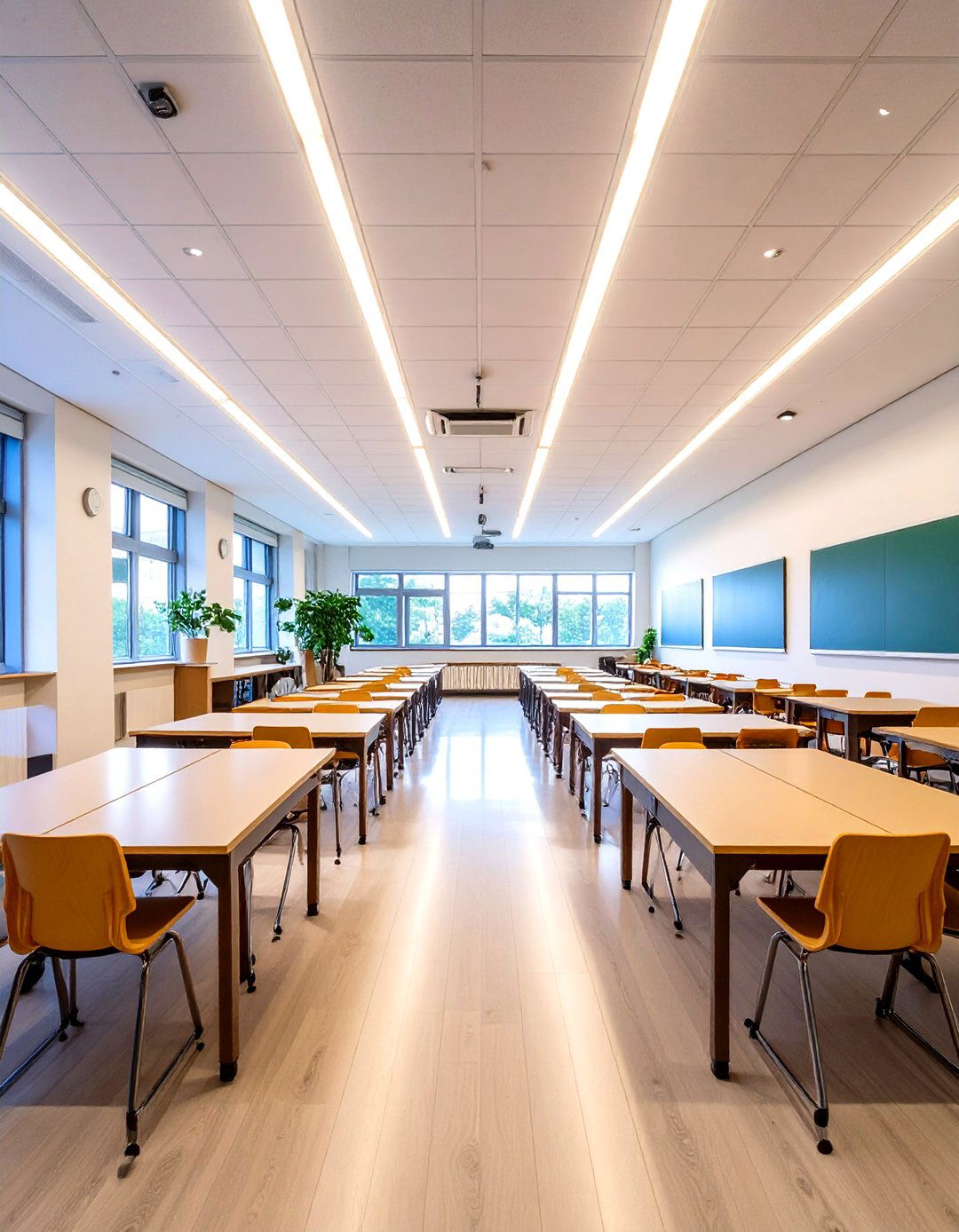
Dimmable LEDs adapt lighting to fit different needs, whether students are watching movies, working in groups, or engaging in various classroom activities. This versatile lighting control allows teachers to create appropriate illumination levels for diverse educational activities throughout the day. High-quality LED lights offer cool white color temperature between 4,000K and 5,000K that closely mimics natural light sources, proven most effective for learning environments. Dimmable systems support different learning scenarios by providing bright illumination for detailed work and softer lighting for relaxation or multimedia presentations. The technology helps teachers create optimal visual environments that support student focus and comfort while reducing energy consumption. Modern dimmable classroom lighting integrates with smart building systems, automatically adjusting based on occupancy, time of day, or available natural light to maintain ideal learning conditions.
Conclusion:
Effective classroom lighting significantly impacts student performance, comfort, and overall learning outcomes. These twenty lighting ideas demonstrate how thoughtful illumination design can transform educational environments while supporting diverse learning activities. From energy-efficient LED panels to interactive technology integration, modern classroom lighting solutions offer unprecedented flexibility and functionality. By implementing appropriate lighting strategies, educators can create engaging, comfortable spaces that enhance focus, reduce eye strain, and support successful learning experiences for all students.


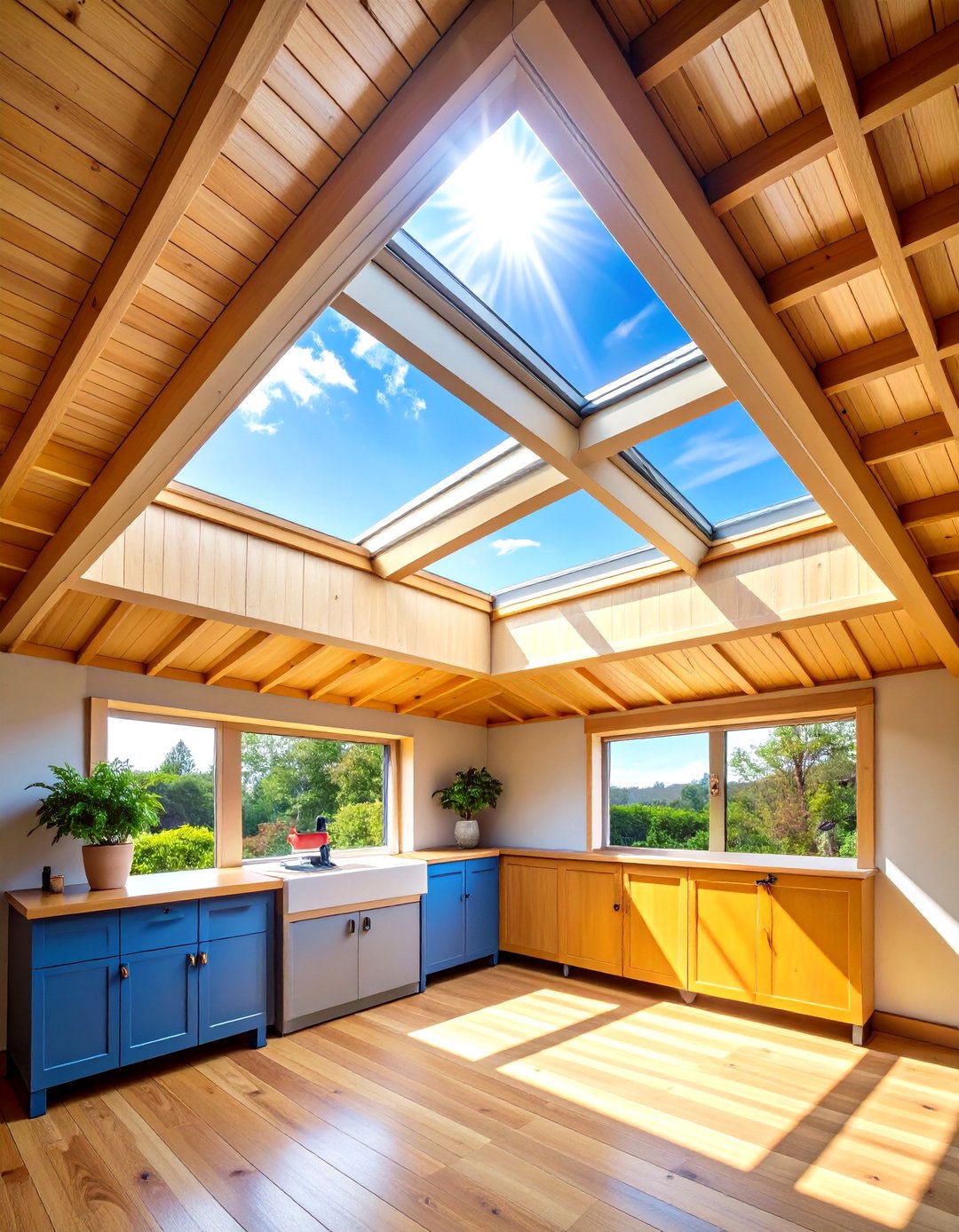
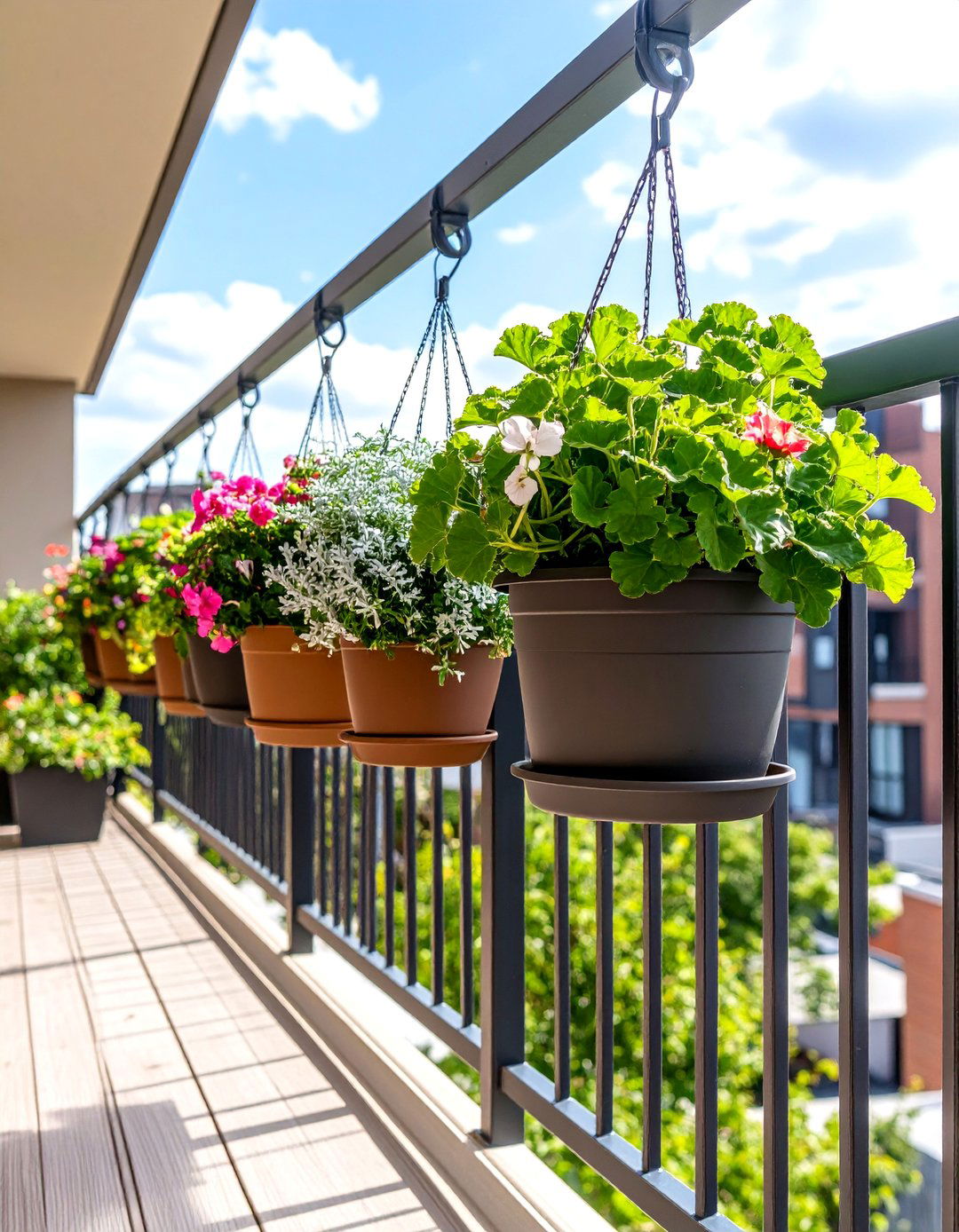
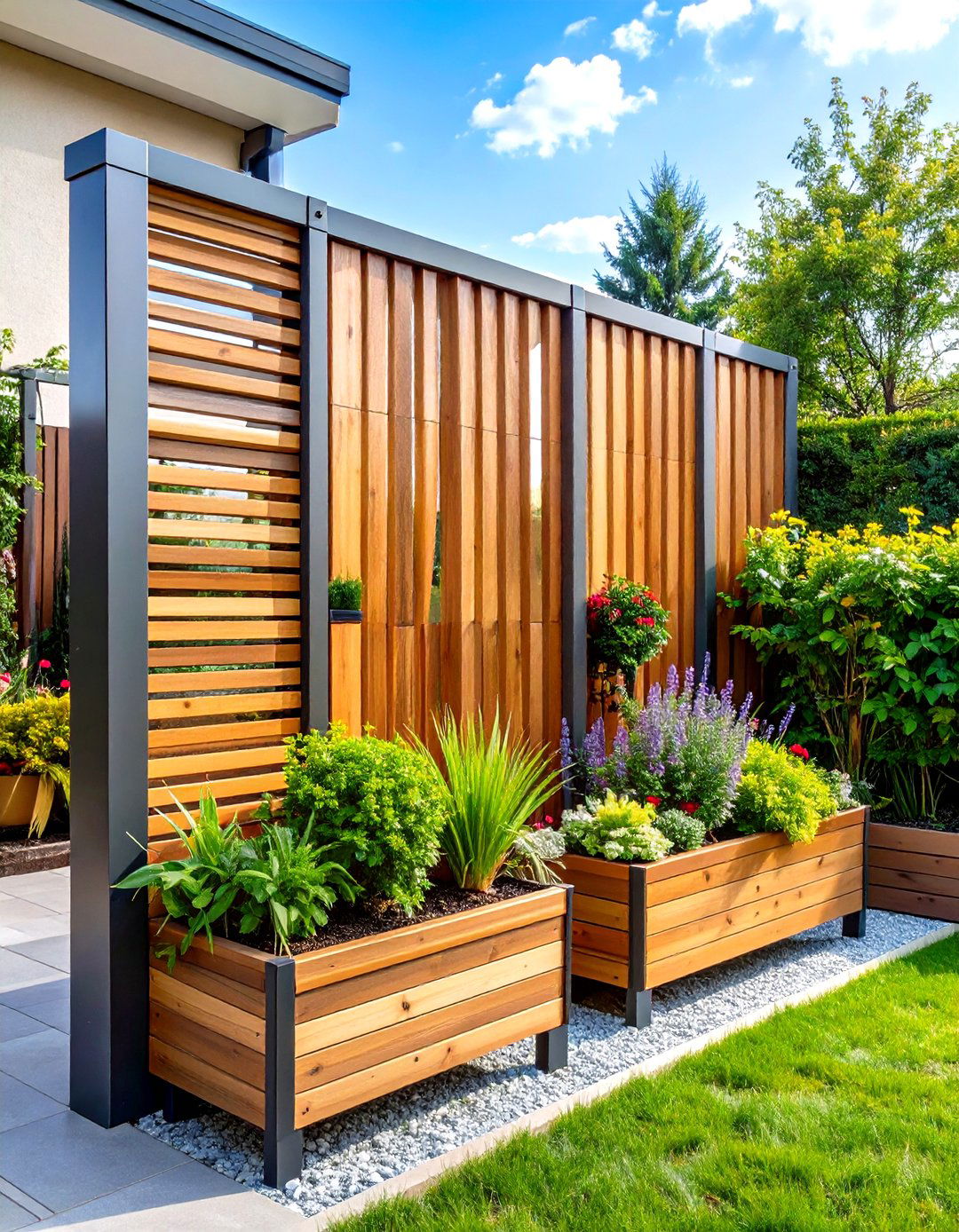
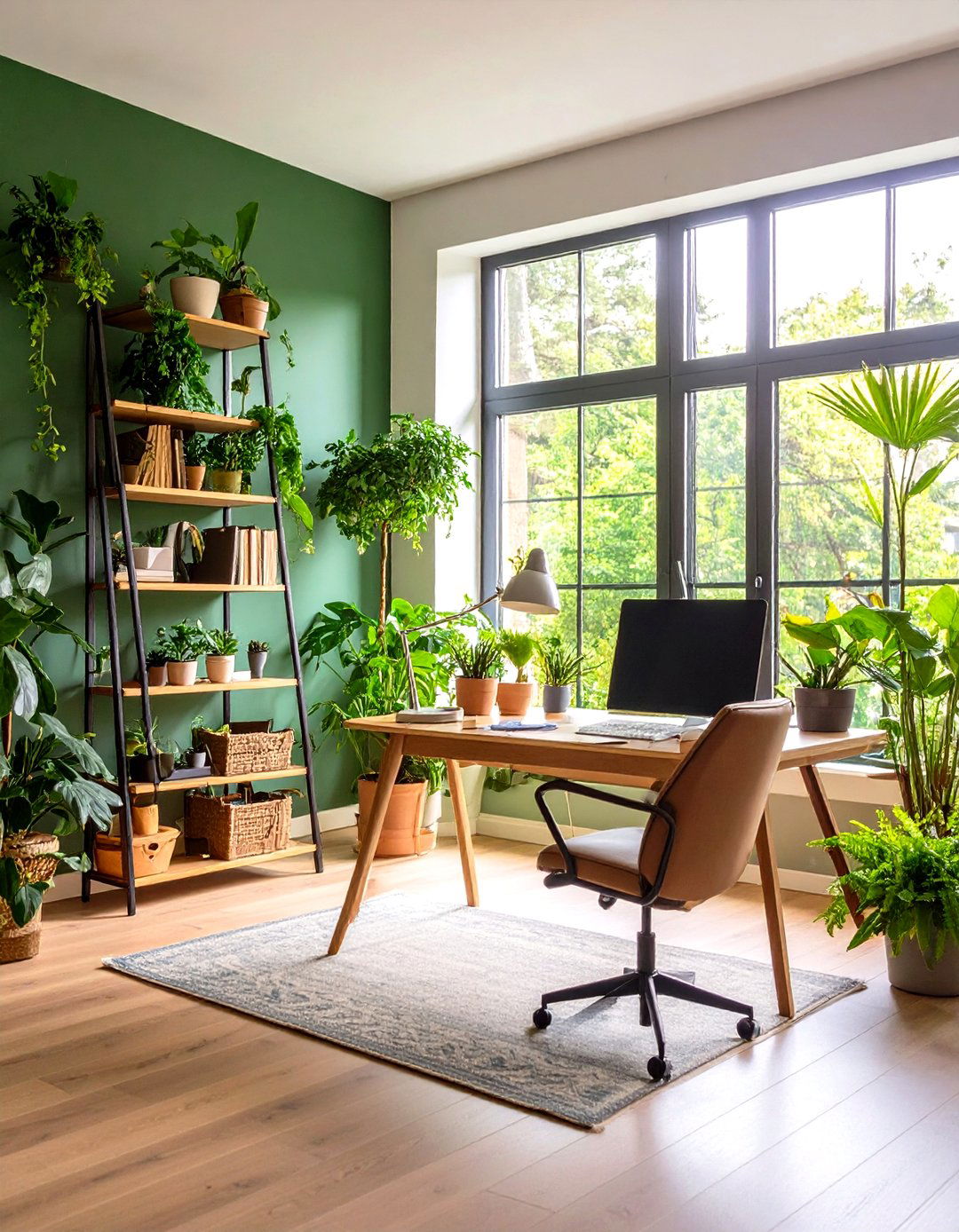
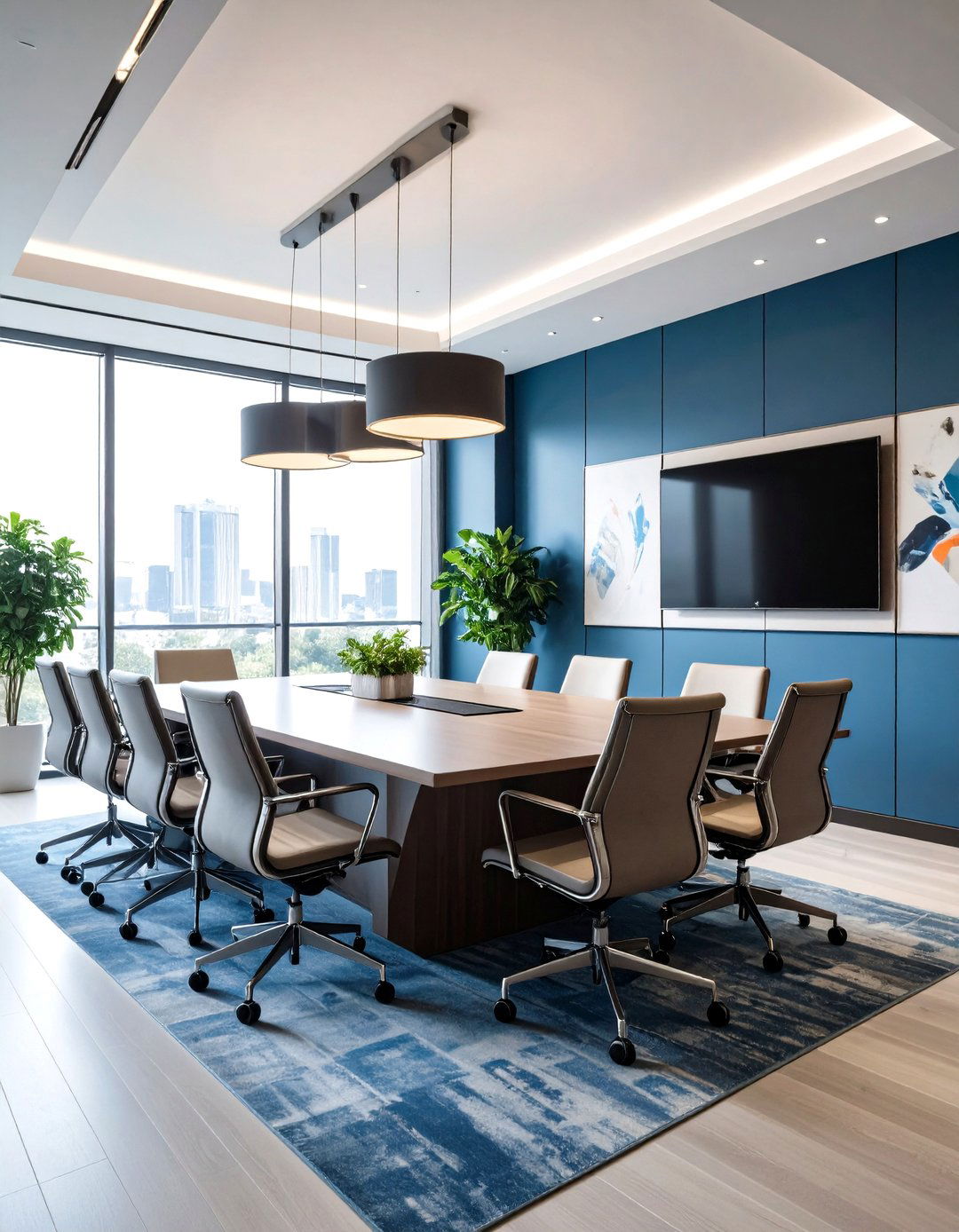
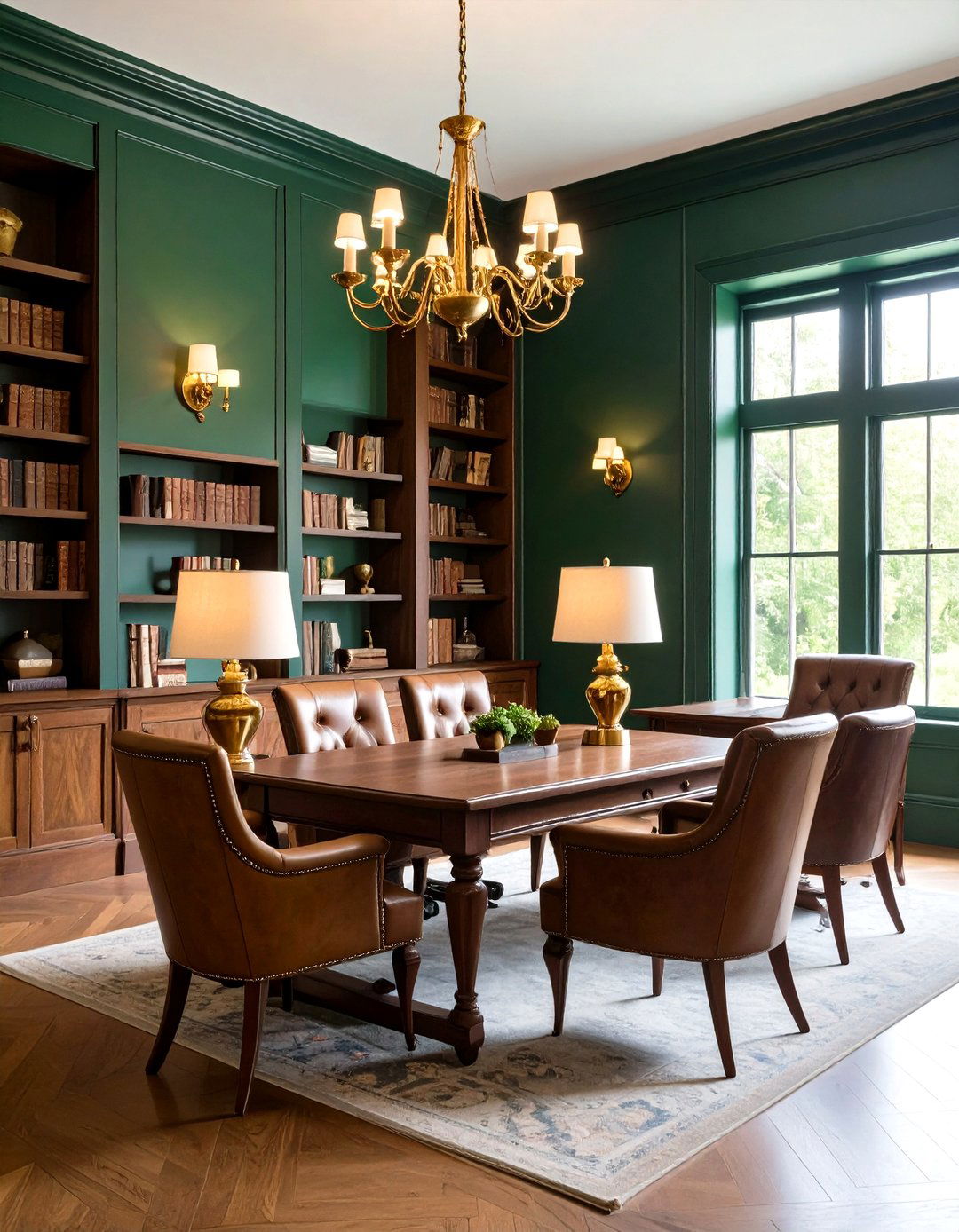
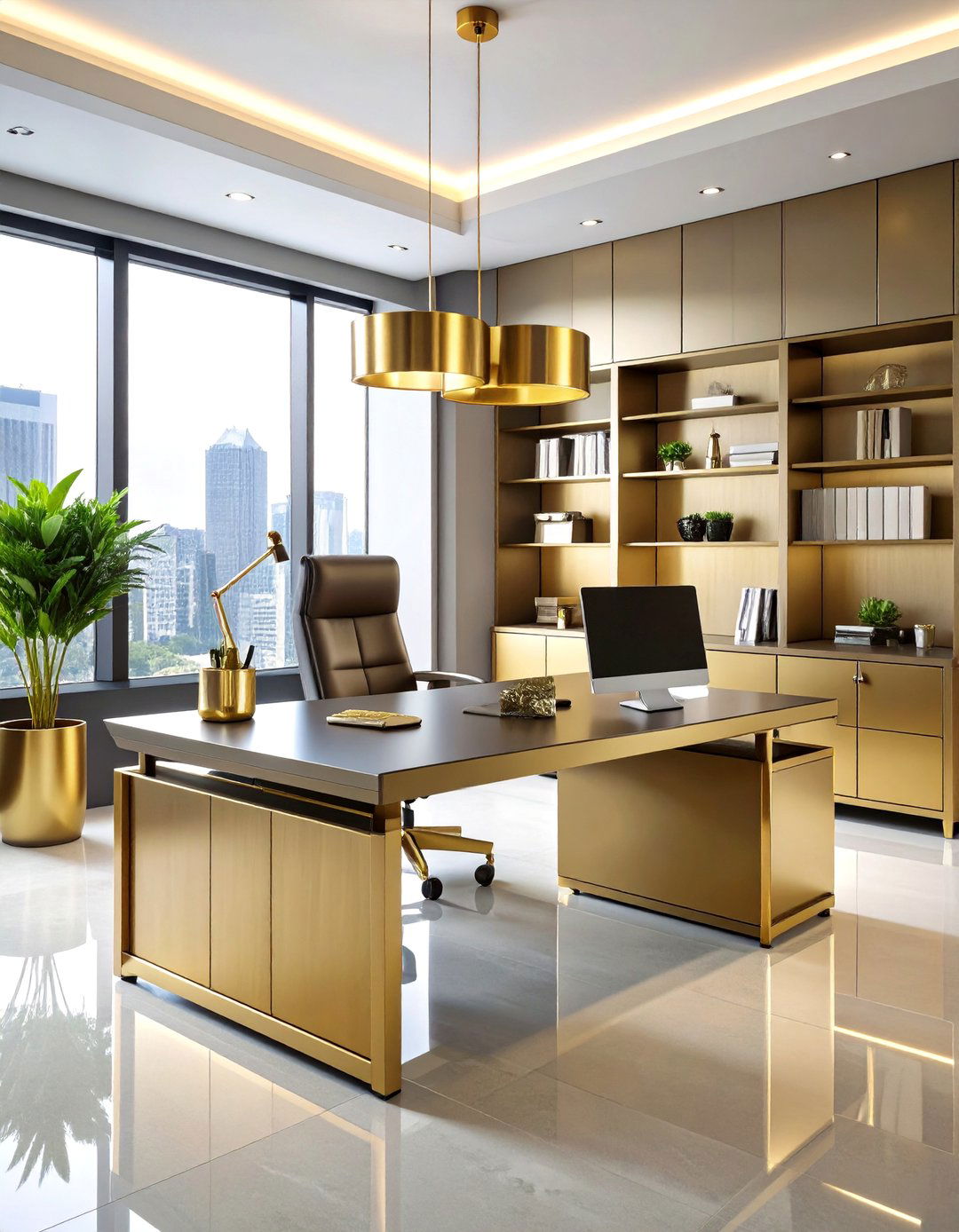

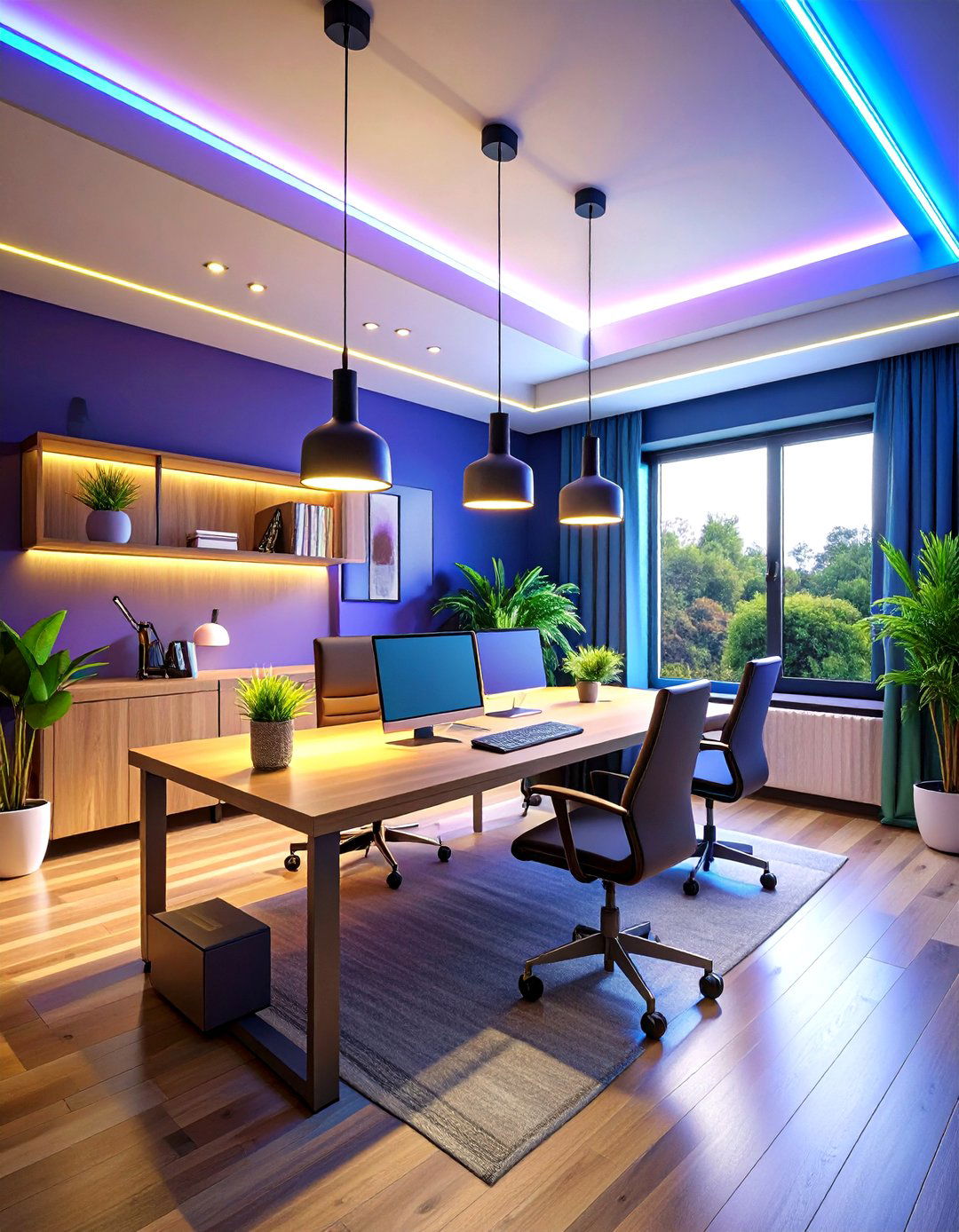

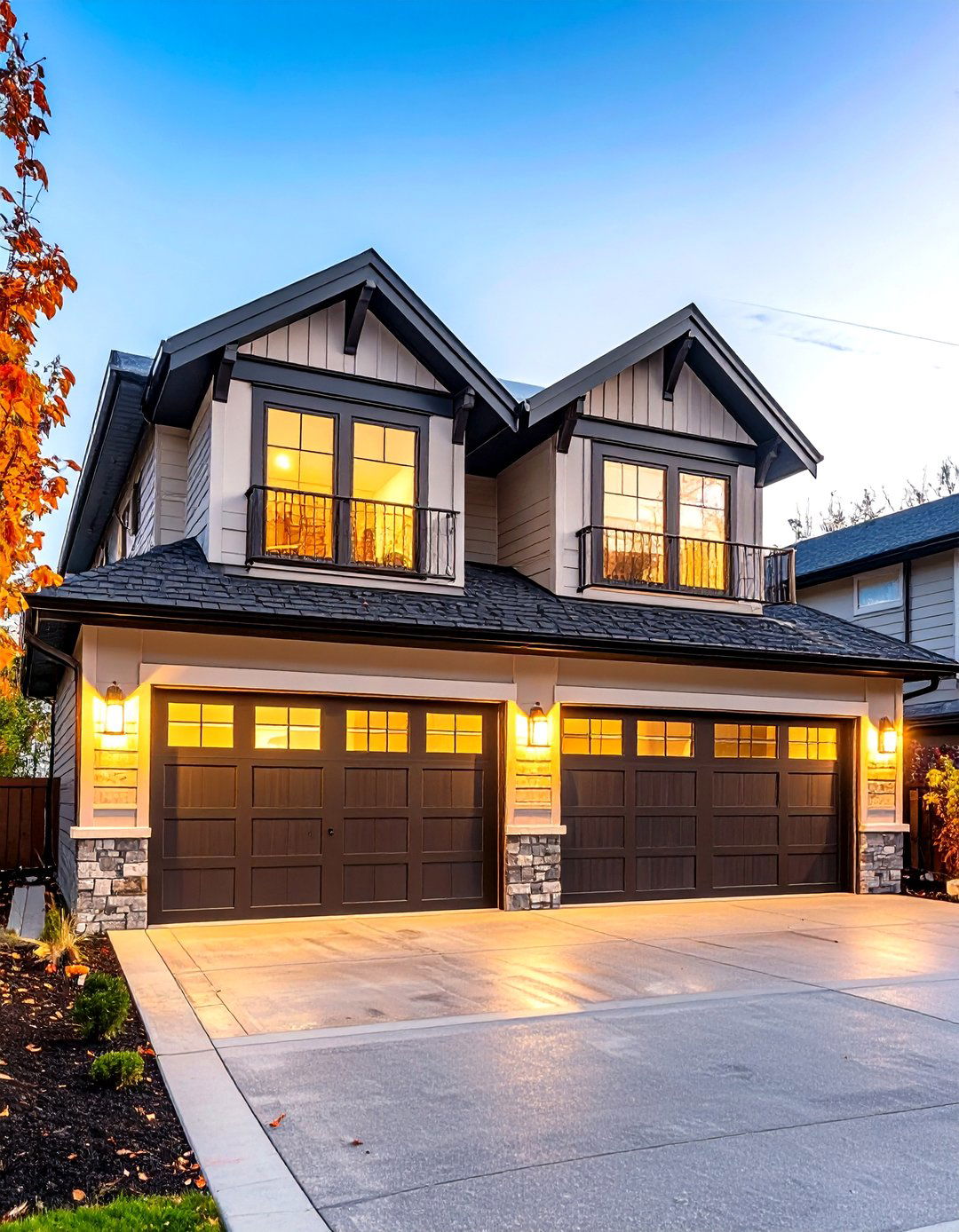


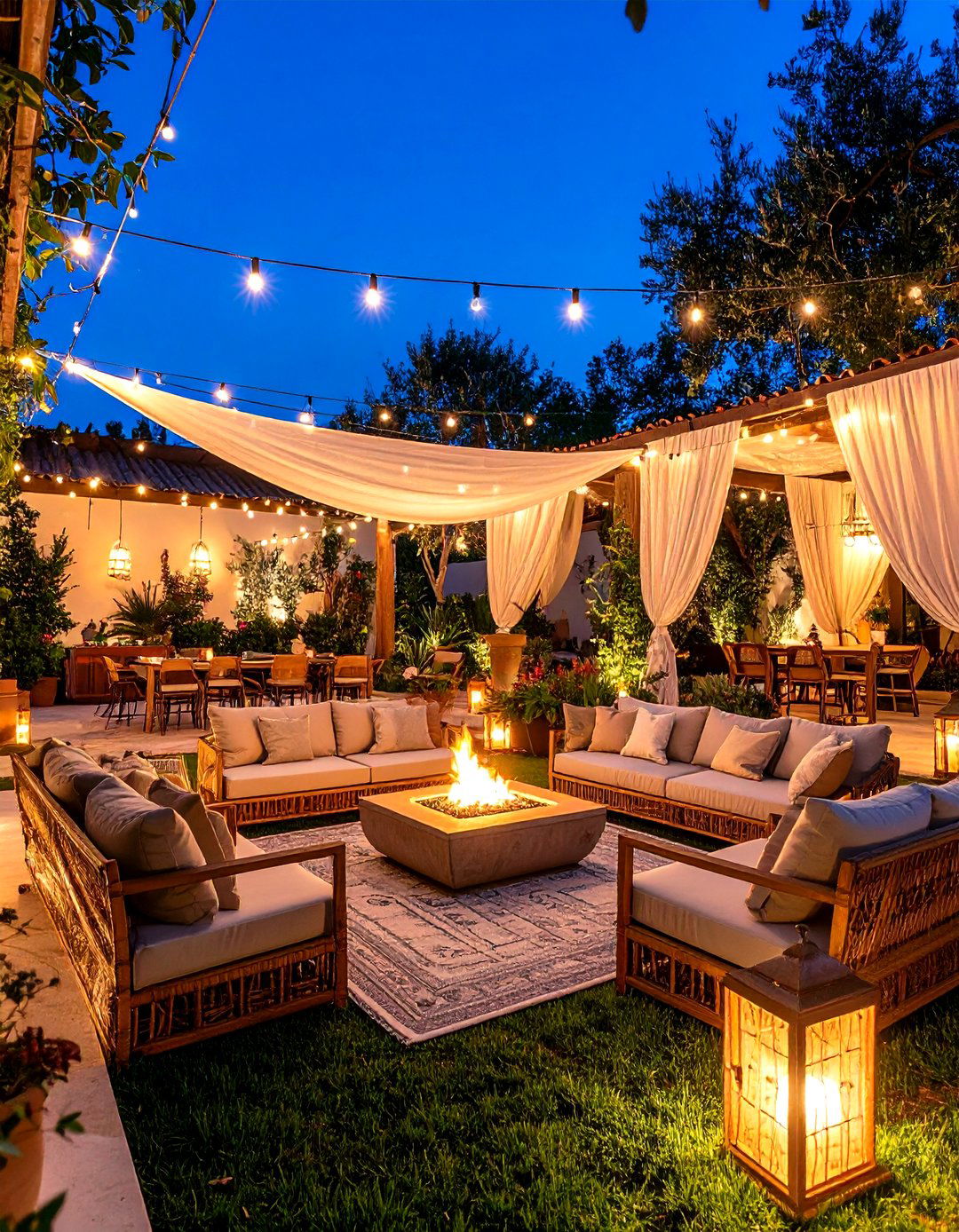

Leave a Reply